|
Me Sahyadri |
|
April 2018 |
|
Volume 5, number 8, # 62 |
|
Mysteries of Maval Caves – Pillars of Karle Chaityagriha (Right Pillars 17 to 8) |
Please use minimum 1280 pixel horizontal screen resolution for viewing. Please be patient while all the images in webpage are loaded. Please do not use the images for any commercial use without permission. Text in Marathi and English is not exact translation. Please give sufficient time to allow the photographs to load. Special thanks to those who helped me during the compilation and for the help and guidance during the activity. |
|
|
|
|
देशाची आर्थिक प्रगती व्हावी असे सर्व नागरिकांना वाटणे सहाजिक आहे. अर्थकारणामुळे मिळणारा रोजगार, समृद्धी यासाठी सर्वांनाच आर्थिक प्रगती हवी हवीशी वाटते. आर्थिक प्रगती होताना, त्याचा दिर्घकाळात समाजावर, निसर्गावर, वातावरणावर दुष्परिणाम होणार नाही याची काळजी घेणे महत्वाचे आहे. मनुष्याच्या भावी पिढ्यांना पाणी, शुद्ध हवा, योग्य वातावरण मिळत रहावे अशी भावना मनात रुजणे महत्वाचे आहे. वाढत्या आर्थिक प्रगतीमुळे नैसर्गिक संपदेवर ताण येतो. प्रगतीसाठी प्रदुषण होते. जंगले, माळराने, व इतर अधिवास नष्ट होतात. वसुंधरेवर रहाणाऱ्या इतर जीवांचा मात्र मनुष्य फारसा विचार करत नाही. आर्थिक प्रगती करताना, मनुष्य निसर्गाची हानी करत आहे. मुळताच माणसाला निसर्गाचे महत्व समजणे हे सध्याच्या आपल्या प्रगत जीवनशैली मुळे अवघड झाले आहे. आर्थिक प्रगती, समाजाची प्रगती व निसर्ग संपदेची निगा, यांचा समतोल राखणे काळाची गरज आहे.
सह्याद्री (पश्चिम घाट) हा एक नैसर्गिक संपदेचा, वैविध्यतेचा, भौगोलिक व ऐतिहासिक ठेवा आहे. वाढत्या मानवी अतिक्रमणाचा, सह्याद्रीच्या विविध घटकांवर होणारा दुष्परिणाम भविष्यात आपल्यालाच धोका निर्माण करेल, यात शंका नाही. शुद्ध पाणी, हवा व उर्जा, भावी पिढीला मिळण्यासाठी, नंद्यांचे उगम असलेला सह्याद्री व त्याभागातील जंगले टिकवणे महत्वाचे आहे. सह्याद्रीच्या महत्वाच्या घटकांचे महत्व छायाचित्रांद्वारे प्रकट करण्याचा मी येथे प्रयत्न केला आहे. येथील पक्षी, प्राणी, वनस्पती, अधिवास, किल्ले व लेणी अशा विविध विषयांबद्दल आपण समजुन घेऊ.
|
|
As the economic development has taken the center stage, the balance between the environmental sustenance and socio economic development will be under the scanner. As most experts with balanced views have proclaimed, Indian wildlife and ecological system sustenance will be under threat, unless precautions are taken with the help of appropriate research and long term national interests. As we encounter the economic development, many habitats which indirectly or directly help sustainable development will be damaged. The awareness to gauge the success by sustainable development and not by year to year growth is a distant dream any environmentalist will assume in current scenario.
Western ghats, or Sahyadri as we all call it as, is a treasure trove of spectacular landscapes, biodiversity, flora, fauna, some amazing geological wonders and man made monuments. With the increasing pressure from human encroachment, all these elements are under stress and in turn are under depletion. Western ghats should be left untouched by human beings, to protect their future generations from getting short of resources, such as water, energy and clean air. The important elements of western ghats, which need protection are highlighted in the new version of Photo journal, Me Sahyadri Magazine.
|
|
|
| |
 
|
| |
| Me Sahyadri – April 2018 - B
|
| |
|
|
मावळ लेणी मोहेमेचा सारांश :
मावळातल्या लहान लेण्यांचा शोध घेण्यात जेवढे कष्ट पडले, तेवढेच कष्ट बेडसे, कार्ले, आणि भाजे च्या लेण्यांतील बारकावे समजवुन घेताना पडले. या लेखात कार्ले लेण्यातील काही सुंदर बारकाव्यांचा पसारा मी इथे मांडला आहे.
मावळातील भाजे, बेडसे आणि कार्ले लेणी अप्रतिम आहेत. त्यामुळे या भागातील इतर लहान लेण्यांकडे फारसे कोणी फिरकत नाही. आम्ही चार समविचारी मित्रांनी मात्र या हरवलेल्या लेण्यांची शोधाशोध करण्याचे ठरवले. साईप्रकाश बेलसरे, निनाद बारटक्के, अमेय जोशी आणि विवेक काळे असा संघ तयार झाला. एकोणीसाव्या शतकात जेम्स बर्जेस आणि जेम्स फर्ग्युसन या दोन इंग्रज विद्वानांनी भारतातील लेणी धुंडाळली. त्यांनी १८८० साली "केव्ह टेम्पल्स ऑफ इंडिया" या पुस्तकाचे प्रकाशन केले. या पुस्तकात मावळातील लहान लेण्यांचा फारसा तपशिल नसला तरी, या मावळातील इतर लहान लेण्यांबद्दल ५-६ वाक्यांमध्ये आम्हाला त्रोटक का होईना माहिती मिळाली. त्यांनी उल्लेख केलेली, काही ठिकाण सापडली, तर काही ठिकाण काहीही केल्या सापडेनात. कदाचित न सापडलेली ठिकाण नष्ट झाली असावीत. पण मोहिमे दरम्यान नविन, ज्या ठिकाणांचा पुस्तकात उल्लेख नव्हता, पण ग्रामीण भागातल्या स्थानिकांना माहिती होती अशी ठिकाण सापडली.
जेम्स बर्जेस आणि जेम्स फर्ग्युसन या दोन इंग्रज विद्वानांनी लिहिलेल्या प्रत्येक शब्दाचा धागा म्हणुन वापर करायचे ठरले. कामांचे वाटप झाले.
शोध मोहिमेत लागणाऱ्या खाऊची सोय करणे, विषय आणि ठिकाणाचा आधी अभ्यास करणे, प्रवासाची सोय करणे, गावकऱ्यांकडे लेण्यांबद्दल चौकश्या करणे, मोहिमे दरम्यान गचपणातुन वाट शोधणे, लेण्याच्या अवशेषांची मोजमाप घेऊन त्याची चित्रे/नकाशे काढणे, छायाचित्रे काढणे, जि. पि. एस. यंत्रावर वाटेबद्दल माहिती नोंदवणे, लेण्यात लहान बारकावे शोधणे, लेण्यांचे विश्लेषण करणे, नोंदी करणे, अशी वेगवेगळ्या प्रकारची काम वाटुन घेण्यात आली.
प्रत्येक ठिकाणी जाताना, घरचा अभ्यास करावा लागला. जुनी पुस्तके, नकाशे धुंडाळले गेले. गावातल्या मित्रांची मदत झाली. गावागावात चौकश्या केल्या. गडद, लेणे, गुहा, कपार, भोगदा, विहार, पांडवांनी एका रात्री बनवलेली गुहा असे अनेक शब्द वापरुन चौकश्या झाल्या. बहुतेक वेळा असे काही नाही इथे ! तुम्ही कुठुन आलात ? असे उत्तर मिळाले. लेणे आहे का इथे कुठे असा प्रश्न विचारला तर आम्हाला बहुतेकांनी कार्ले/बेडसे/भाजे लेण्यांचा पत्ता दिला. पण बकऱ्या, गाई घेऊन डोंगरात फिरणारे गुराखी मात्र दरवेळेला मदतीला धाउन आले. वाटांचे आणि दिशांचे अंदाज मिळाले. जुजबी माहिती घेऊन ठिकाण शोधणे या प्रकाराचा चांगला सराव झाला. कधी काटेरी करवंदींच्या खालुन खुप सरपटाव लागल तर कधी घसाऱ्यावर हात टेकावे लागले.
लेण्यांमध्ये मोठे कोळी (स्पायडर), कातळ पाली, वटवाघळ, मधमाश्या, पाकोळ्या, घुबडं भेटले. आमच्या मुळे त्यांना उगाच त्रास झाला, असा अपराधीपणा वाटला. प्रत्येक शोधमोहिमेला यश आलेच असे नाही. काही ठिकाण सापडली नाहीत. तर काही ठिकाण आमच्याच मनाचे खेळ आहेत असे लक्षात आले. बहुतांश ठिकाणी कोणत्या ना कोणत्या प्रकारची जोखिम होती. वटवाघळ, लेण्यातील धुळ, काळोख, मधमाश्या, काटेरी वनस्पती, घसारा, गुहेतील ऑक्सिजन चा अभावआणि इतर न दिसणारे धोके यावर मात झाली. मोहिमेसाठी, विजेऱ्या, जि. पि. एस., मोजपट्या, दोऱ्या, लेजर यंत्र, नकाशे, गुगल मॅप, जाळीच्या टोप्या या सर्व जंत्रीचा उपयोग झाला. एकूण मिळुन २० नविन अपरिचित ठिकाण/वास्तु पहायला मिळाल्या, मावळाचा भुगोल जरा अजुन नीट लक्षात आला. नविन प्रश्न पडले आणि नविन कोडी सोडवयाला मिळाली. तर्क वितर्क झाले.
|
|
About the Maval Cave exploration :
The main caves in Maval region are so significant, but often overlooked by the visitors when it comes to the details. In this photoessay I have tried to bring few details at Karle caves to surface.
The main caves in Maval region are so significant that other small hermit caves are often overlooked. We as a team of four like minded friends, decided to explore the Maval region for these small hermit caves. We explored and found few beautiful places. The very concept of creating a hermit cave somewhere high up in the hills is fascinating. These places often are full of tranquility and nothing else. With very little architectural evidences and clues, the academicians have obviously ignored these places. It was James Fergusson and James Burgess, during their exhaustive study of “Cave temples of India, 1880” mentioned few of these hermits in Maval region of Pune district. With the little clues and exhaustive investigation, team of four members, Saprakash Belsare, Amey Joshi, Ninad Bartakke and Vivek Kale started the exploration. The journey to locate, trek and analyse these hermit caves itself was fascinating. We met many villagers who were unaware of these places, but also met few shephards who were precisely aware of the hermits and gave us tentaive guidance.
There is a very brief mention about the misceleneous caves of Maval by James fergusson and James Burgess in their work. Based on available information we decided to search these caves and monuments. The activities were planned. The food, travel , track exploration in difficult and routes full of foliage, enquiring the villagers about the caves, taking measurements and drawing skecthes and maps, photography, GPS data collection, making notes and analysing the information, observing the minor details of the caves etc activites were distributed amongst the team members. We met many bats, owls, geckos, lizards, large spiders, martins, honeybees during the treks. Often we felt sad that we disturbed them to see the caves. Most of these places are hazardous due to pitch darkness, bats, dust, thorny plants, honeybees, low oxygen level in caves and rock patches etc. Not all the attemps were successful. Sometimes we could not find the intended places and sometimes we realised that the cave was just our imagination and did not exist. Nevertheless we saw about 20 new strange caves/monuments during the exploration. The high intensity torches, GPS tool, measuring tapes and measuring laser tool, Honeybee protection caps, maps, google maps, photographs etc were useful during the mission.
On this photoessay, I have compiled the information and photographs of the pillars in chaityagriha (Pillar 17 to Pillar 8 on right side).
|
|
|
| |
  |
| The banner has been published here to improve the awareness of the trekkers and tourists visiting the various mountain forts, mountains in north western ghats. Please avoid accidents, by following good outdoor ethics such as no swimming in cisterns at mountain forts, no rock climbing without proper technical equipment and expertise. Please do not adventure, trek with any group or individually without understanding the risks associated. The frequency of the solo trekker fatalities have increased recently. Please strictly avoid solo treks. Please also avoid treks to mountains in large commercial groups, as it leads to damage to biodiversity of these high elevation ecological islands. Please respect the wildlife and biodiversity of the region. This has become more important as the ever increasing human interference is leading to severe damage to fragile ecosystems. Please be aware of the wildlife and biodiversity of the mountains before visiting these mountains. Please follow outdoor ethics. Follow ASI and Forest department rules. The concept of use of symbols for outdoor ethics was conceived and designed by "Sahyadri Trekker Bloggers Group". |
| |
|
|
| |
 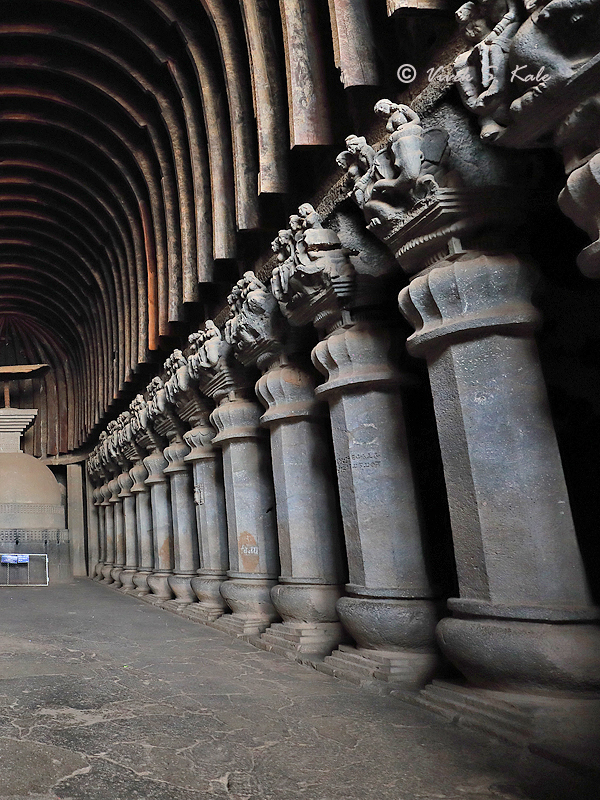 |
| |
| 1. Chaityagriha, Karle Caves, Maval Tehsil, Pune district, Maharashtra, India |
| |
|
|
कार्ले येथील चैत्यगृह भारतातील सर्वात भव्य व अप्रतिम चैत्यगृह आहे. चैत्यगृहाची लांबी दरवाजापासुन मागच्या भिंतीपर्यंत ३७.८ मीटर आहे. चैत्यगृहाची रुंदी १३.८ मीटर आहे. चैत्यगृहाची उंची १४ मीटर आहे. छत अर्धवर्तुळाकार आकाराचे आहे. चैत्यगृह खांबांमुळे दोन भागात विभागलेले आहे. खांबांच्या मागचा भाग आणि खांबांसमोरचा मुख्य भाग असे दोन भाग आहेत. डावीकडची आणि उजवीकडची खांबाची रांग स्तुपाच्या मागे अर्धवर्तुळात एकमेकांना मिळते.
चैत्यगृहातले कोरलेले खांब अप्रतिम आहेत. खांबाच्या सर्वात खाली तीन चौकटी आहेत. चौकटींवर खांबांना अर्ध गोल माठासारखा आकार दिला आहे. त्याच्यावरचा खांब अष्ट्कोनी आहे. वरच्या भागात पाकळ्या असलेल्या कमळाचा आकार आहे. त्यावर असलेल्या चौकटींवर हत्ती, घोडे व इतर प्राण्यांवर आरुढ मानवी शिल्पे आहेत. खांबांच्या वर पुढे व मागे दोन्ही बाजुस मानवी शिल्पे आहेत. पुढच्या भागात हत्तीवर आरुढ शिल्पे आहेत, मागच्या बाजुस मानवी शिल्पे हत्ती, घोडे, आणि सेंटॉर/स्फिंक्स वर आरुढ आहेत. एकुण मिळुन ४१ खांब आहेत. दरवाज्याच्या जवळचे सज्जाच्या खालचे चार खांब अष्ट्कोनी नाहीत. इतर सर्व खांब अष्टकोनी आहेत. स्तुपाच्या जवळच्या सात अष्टकोनी खांबांवर शिल्पे नाहीत.
|
|
The chaityagriha at Karle is the biggest of its type in the whole of India. The hall measures 37.87 m deep from door to back. It is 13.87 m wide and 14.02 m high. This chaitya consists of an apsidal hall with a front verandah. The apsidal means the semicircular recess roof. The hall is divided into a nave (central open space) and two aisles (passages) by two rows of pillars. The two rows of pillars meet at the rear behind the stupa in a semicircle forming the semicircular recess.
The pillars are executed with the great ingenuity which reflect the sculptural art of the period. The pillars consist of a stepped base surmounted by a pot, octagonal shaft over it, the capital of inverted flower vase member, caged amalaka and an inverted stepped pyramid. Above this inverted stepped pyramid there are sculptures of animals with human riders, facing both aisle and main hall. The animals on the capital consist of elephants, horses and centaurs/sphinx like mythological animals. Centaurs are greek mythological animals with human face on horse body. There are total 41 pillars in Chaitya griha. The four pillars parallel to front wall near the entrance are non octagonal and support the beam. There are seven pillars around Stupa which are octagonal but without sculptures atop.
|
|
|
| |
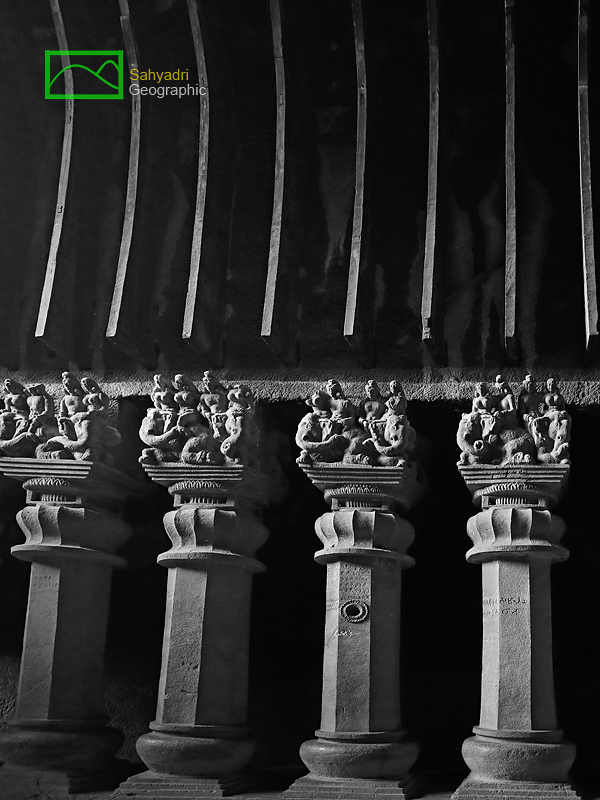 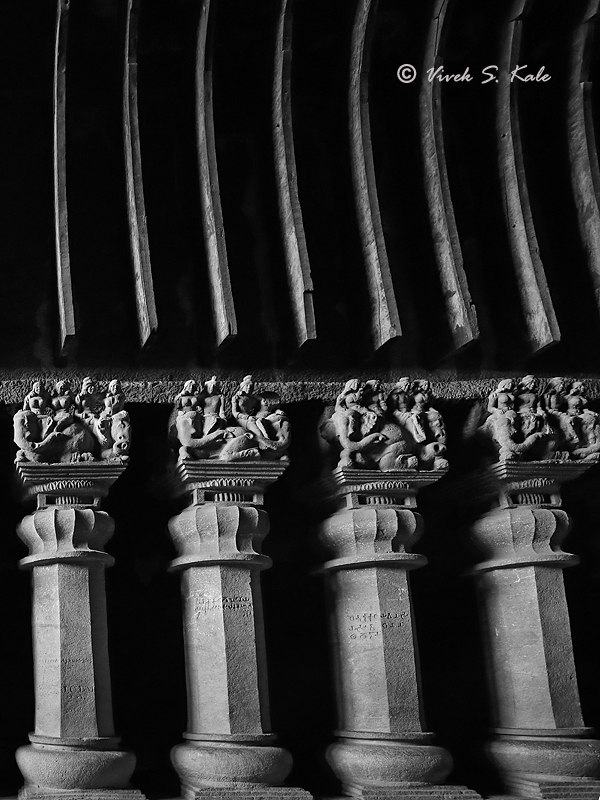 |
| |
| 2. Pillars at Chaityagriha, Karle Caves, Maval Tehsil, Pune district, Maharashtra, India |
| |
|
|
| |
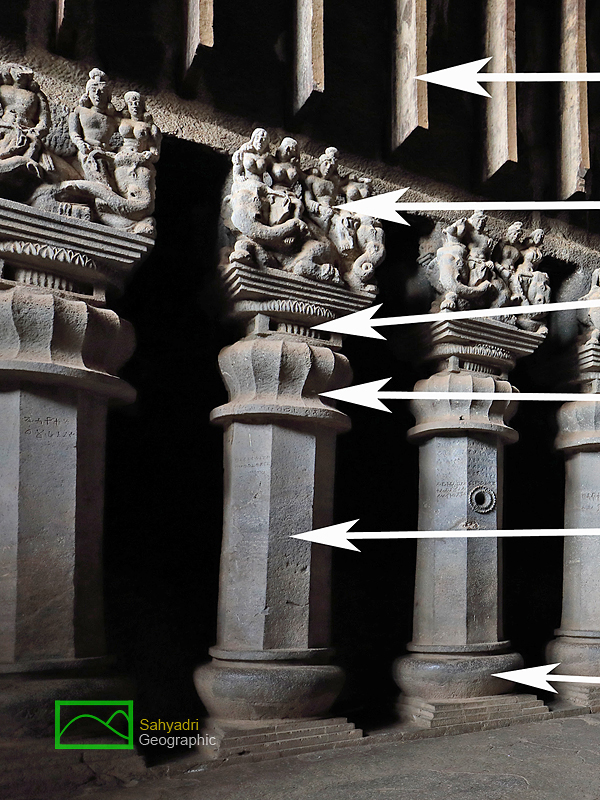 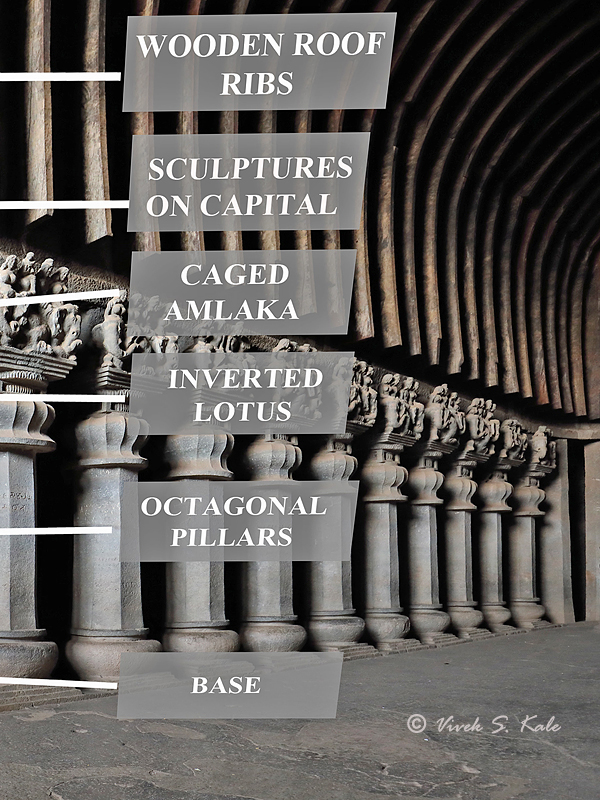 |
| |
| 3. Pillars at Chaityagriha, Karle Caves, Maval Tehsil, Pune district, Maharashtra, India |
| |
|
|
| |
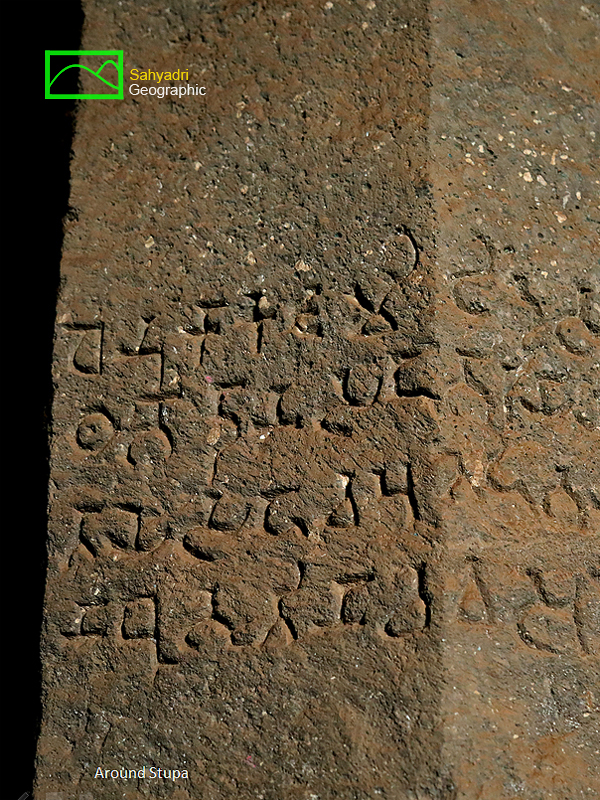 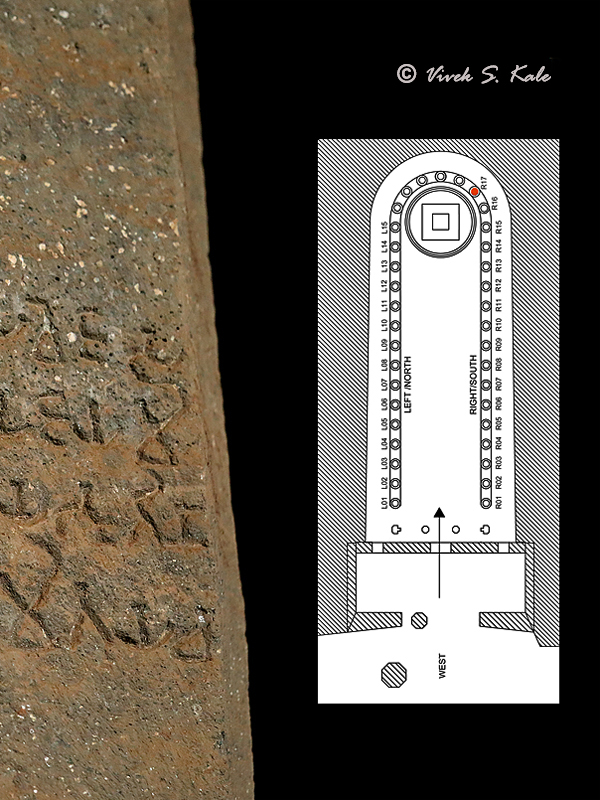 |
| |
| 4. Inscription at Pillar R17, Chaityagriha, Karle Caves, Maval Tehsil, Pune district, Maharashtra, India |
| |
|
|
कार्ले चैत्यगृहात मुख्य स्तूपाभोवती शिल्प नसलेले सात अष्टकोनी खांब आहेत. या खांबांपैकी उजवीकडच्या सतराव्या खांबावर एक शिलालेख आहे. हा शिलालेख ब्राह्मी लिपीत कोरलेला आहे. प्राकृत भाषेत लिहिलेला या शिलालेखाच अर्थ "धेनुकाकटच्या मिलिंद, सह पत्नी जयमिता व पुत्र भयभुति, नाबुभुति व वसुमितय यां कडुन स्तंभाचे दान. " असा आहे.
|
|
Seventeenth octagonal pillar on right hand side (person facing stupa) i.e. on south side in Karla Chaityagriha is shown in the image. This pillar is one of the seven pillars around the Stupa. This pillar does not have any sculptures at its capital. This pillar has Prakrit inscription in Brahmi script. The meaning of the inscription is, "The gift of a pillar by Midimdas, from Dhenukakata, along with his wife Jayamita, sons Bhayabhuti, Nababhuti and daughter Vasumita".
|
|
|
| |
  |
| |
| 5. Inscription at Pillar R17, Chaityagriha, Karle Caves, Maval Tehsil, Pune district, Maharashtra, India |
| |
|
|
| |
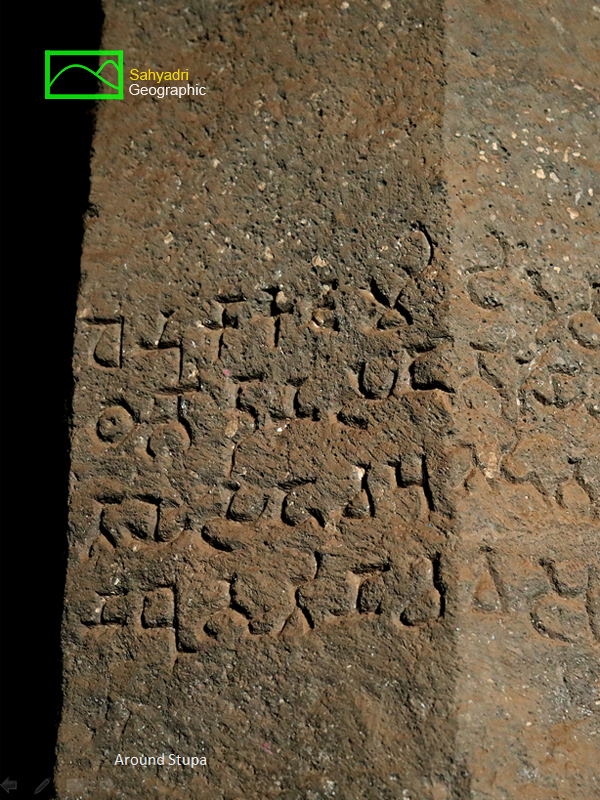 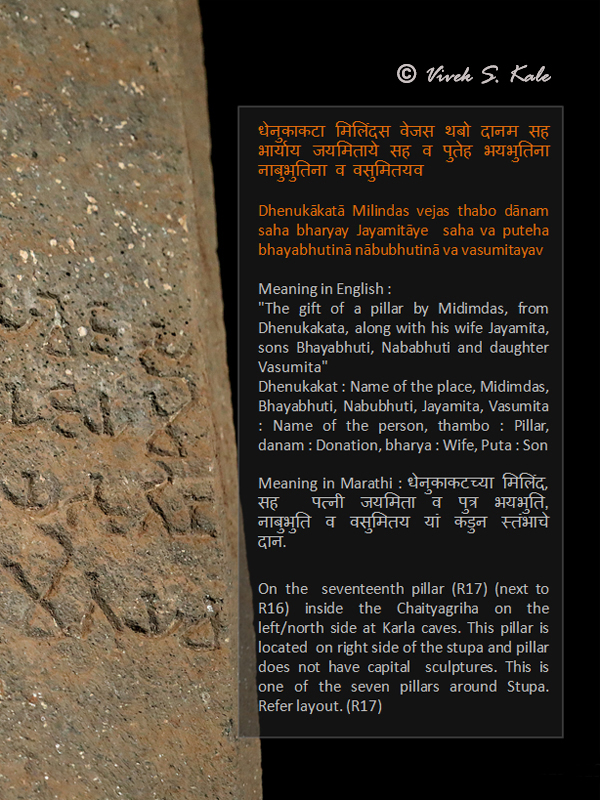 |
| |
| 6. Inscription at Pillar R17, Chaityagriha, Karle Caves, Maval Tehsil, Pune district, Maharashtra, India |
| |
|
|
| |
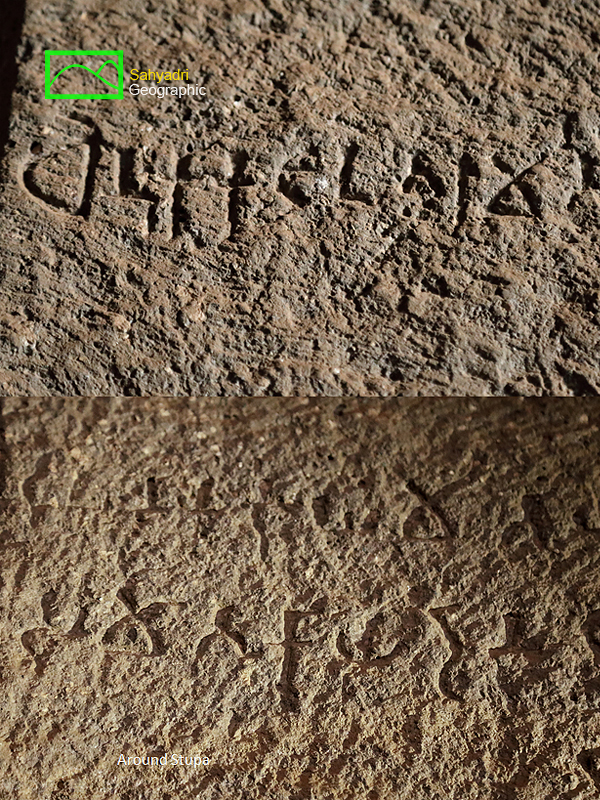 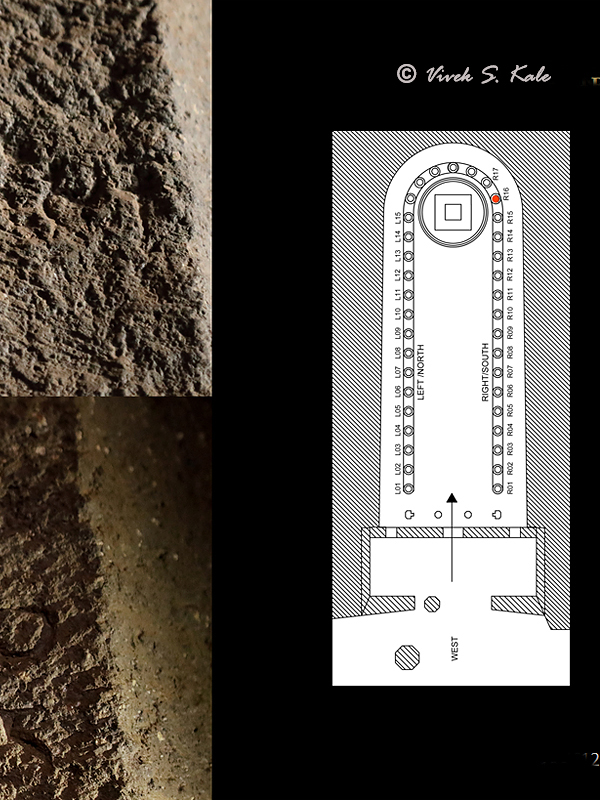 |
| |
| 7. Inscription at Pillar R16, Karle Caves, Maval Tehsil, Pune district, Maharashtra, India
|
| |
|
|
कार्ले चैत्यगृहात मुख्य स्तूपाभोवती शिल्प नसलेले सात अष्टकोनी खांब आहेत. या खांबांपैकी उजवीकडच्या सोळाव्या खांबावर एक शिलालेख आहे. हा शिलालेख ब्राह्मी लिपीत कोरलेला आहे. प्राकृत भाषेत लिहिलेला या शिलालेखाच अर्थ " धेनुकाकटच्या, उतरामती आणी पती दुर्घमिता कडुन स्तंभाकरिता दान." असा आहे.
|
|
Sixteenth octagonal pillar on right hand side (person facing stupa) i.e. on south side in Karla Chaityagriha is shown in the image. This pillar is one of the seven pillars around the Stupa. This pillar does not have any sculptures at its capital. This pillar has Prakrit inscription in Brahmi script. The meaning of the inscription is, "The gift of a pillar by Utaramati, from Dhenukakata, along with her husband Drughmita".
|
|
|
| |
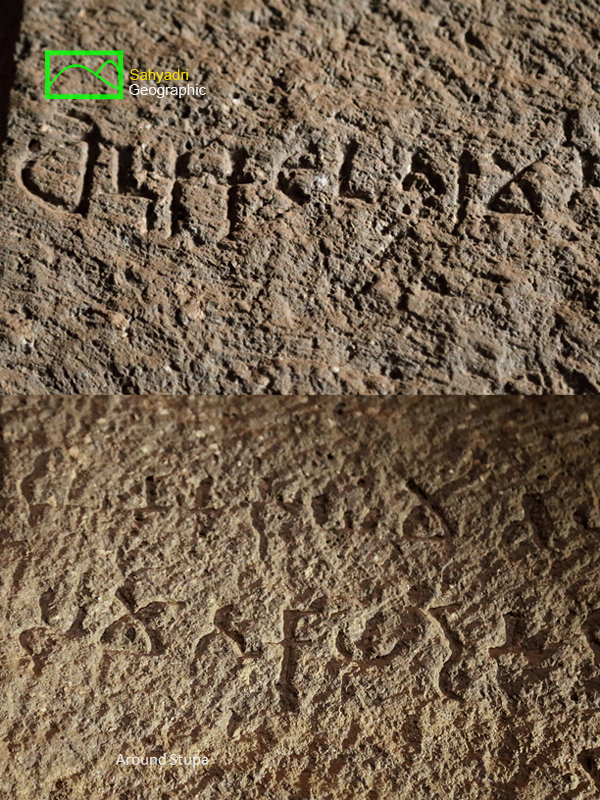  |
| |
| 8. Inscription at Pillar R16, Chaityagriha, Karle Caves, Maval Tehsil, Pune district, Maharashtra, India |
| |
|
|
| |
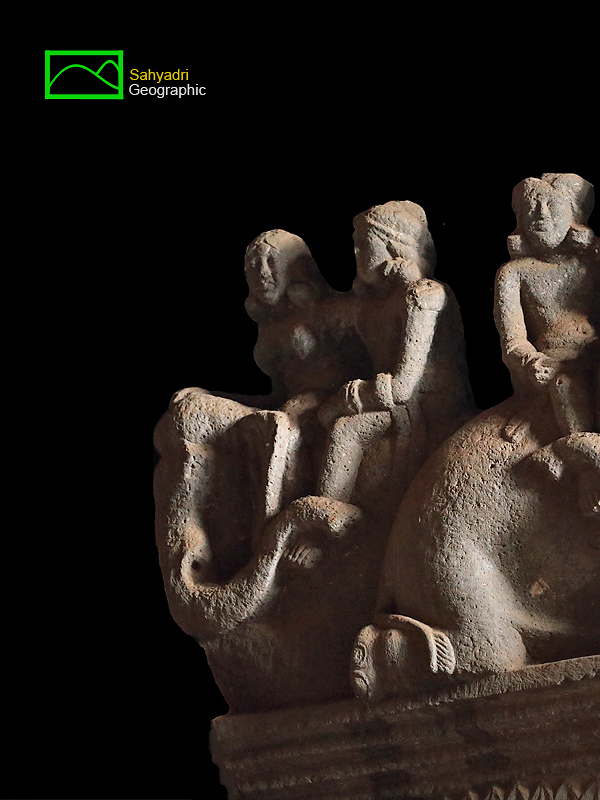 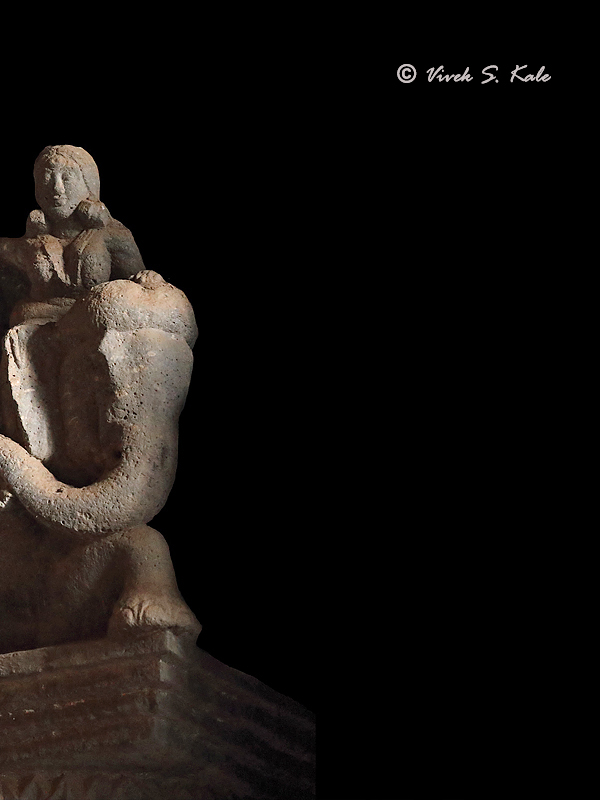 |
| |
| 9. Pillar R15, Chaityagriha, Karle Caves, Maval Tehsil, Pune district, Maharashtra, India |
| |
|
|
छायाचित्रात पंधरावा अष्टकोनी खांब (उजव्या रांगेतली / दक्षिणेकडील रांगेतली) दाखविलेला आहे. छायाचित्रात खांबावरची पुढच्या बाजुची शिल्पे दाखविलेली आहेत. या शिल्पात दोन हत्ती आहेत. दोन्ही हत्तींवर स्त्री-पुरुष जोड़्या आरुढ झालेल्या आहेत. स्त्री शिल्पात कपाळावरची आभूषण (टिका), कर्ण आभूषण, बांगड़्या ही आभूषण दाखवलेली आहेत. पुरुष शिल्पाच्या हातात कडे आहेत. स्त्री आणि पुरुष पारंपारिक परिवेषात आहेत. पुरुष शिल्पात गळ्यात हार आणि हातातील कडे कोरलेले आढळतात.
या खांबावर एक शिलालेख आहे. हा शिलालेख पाली भाषेत ब्राह्मी लिपीत कोरलेला आहे. शिलालेखांचे मराठी भाषांतर " धेनुकाकट चा य़वन चुलयखन कडुन स्तंभाकरिता दान." असे आहे.
या खांबाच्या मागच्या बाजूस स्त्री-पुरुष मेंढा आणि घोड़्यावर आरुढ झालेले पहावयास मिळतात.
|
|
Fifteenth octagonal pillar, (with sculptures on its capital) on right hand side (person facing stupa) i.e. on south side in Karla Chaityagriha is shown in the image. In this image, only the sculptures facing the main hall are highlighted and the image does not show the other details such as top of the pillar, backside of the pillar and wall behind. On one of the elephants a human pair of male and female is riding. On the other elephant other human pair of male and female riders can be seen.
Interesting ornaments such as waist jewelry, large anklets and forehead jewelry can be seen here on the female riders. The wrist bracelet can be seen on the male rider. One of the male rider has intricate large sized necklace.
The elephant riders are dressed traditionally.
This pillar has male riding on horse and female riding on ram on the alley side. As per James Fergusson ram has legs like horse and tail like tiger.
This pillar has Prakrit inscription in Brahmi script. The meaning of the inscription is, " The gift of a pillar by Chulayakhan, a Yavana, from Dhenukakata "
|
|
|
| |
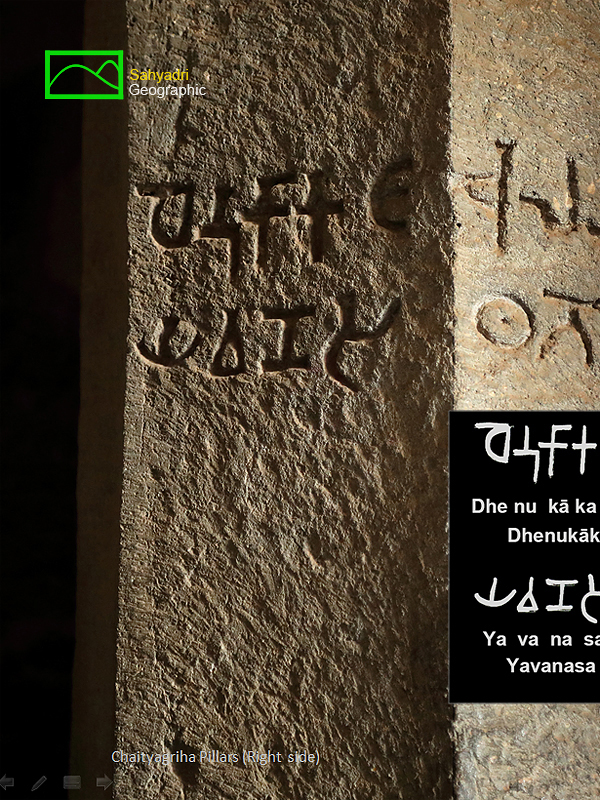 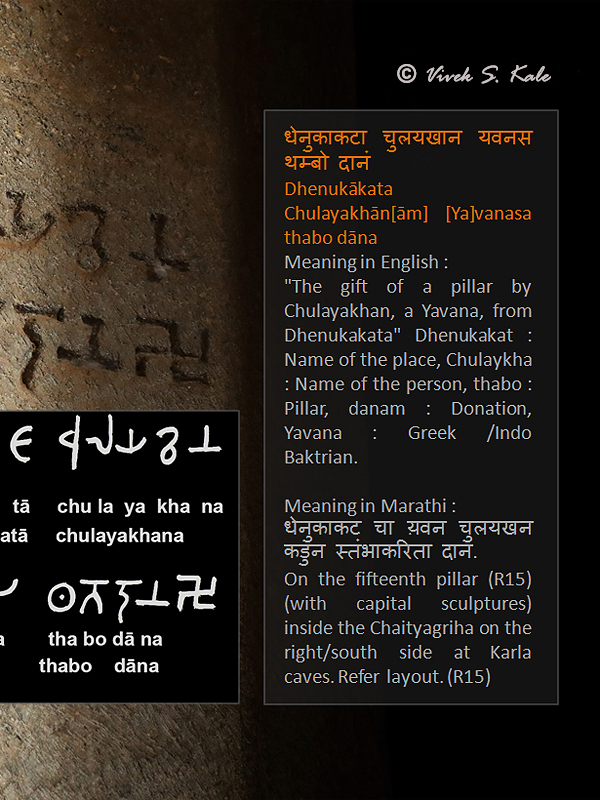 |
| |
| 10. Inscription at Pillar R15, Chaityagriha, Karle Caves, Maval Tehsil, Pune district, Maharashtra, India |
| |
|
|
| |
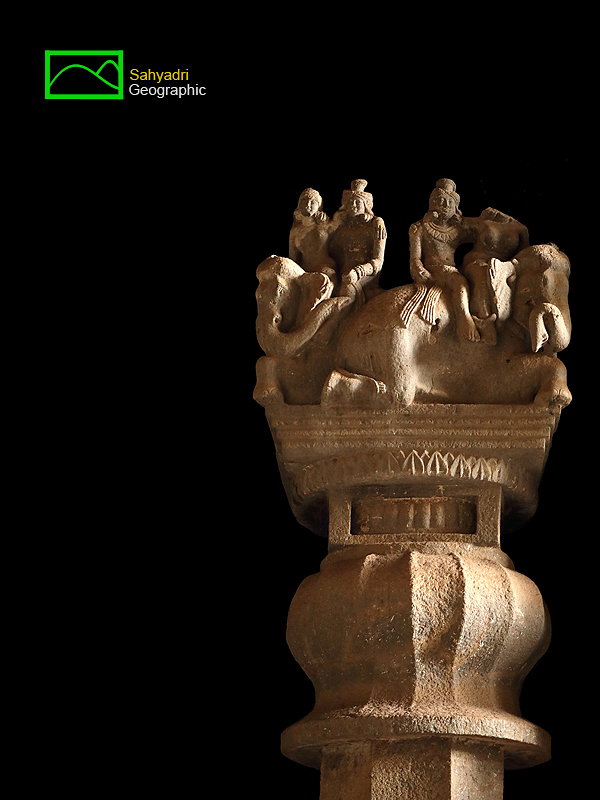  |
| |
| 11. Pillar R14, Chaityagriha, Karle Caves, Maval Tehsil, Pune district, Maharashtra, India |
| |
|
|
छायाचित्रात चौदावा अष्टकोनी खांब (उजव्या रांगेतली / दक्षिणेकडील रांगेतली) दाखविलेला आहे. छायाचित्रात खांबावरची पुढच्या बाजुची शिल्पे दाखविलेली आहेत. या शिल्पात दोन हत्ती आहेत. दोन्ही हत्तींवर स्त्री-पुरुष जोड़्या आरुढ झालेल्या आहेत. स्त्री शिल्पात कपाळावरची आभूषण (टिका), कंबर पटा , बांगड़्या ही आभूषण दाखवलेली आहेत. पुरुष शिल्पाच्या हातात कडे आहेत. स्त्री आणि पुरुष पारंपारिक परिवेषात आहेत. पुरुष शिल्पात गळ्यात हार आणि हातातील कडे कोरलेले आढळतात.
या खांबावर एक शिलालेख आहे. हा शिलालेख पाली भाषेत ब्राह्मी लिपीत कोरलेला आहे. शिलालेखांचे मराठी भाषांतर "धेनुकाकटचा, रोहमितेनचा काका, अगिलसा कडुन स्तंभाकरिता दान. " असे आहे.
या खांबाच्या मागच्या बाजूस स्त्री-पुरुष घोड़्यावर आरुढ झालेले पहावयास मिळतात.
|
|
Fourteenth octagonal pillar, (with sculptures on its capital) on right hand side (person facing stupa) i.e. on south side in Karla Chaityagriha is shown in the image. In this image, only the sculptures facing the main hall are highlighted and the image does not show the other details such as top of the pillar, backside of the pillar and wall behind. On one of the elephants a human pair of male and female is riding. On the other elephant other human pair of male and female riders can be seen.
Interesting ornaments such as waist jewelry, large anklets and forehead jewelry can be seen here on the female riders. The wrist bracelet can be seen on the male rider. One of the male rider has intricate large sized necklace. The elephant riders are dressed traditionally. This pillar has male and female human riders riding on horses on the alley side.
This pillar has Prakrit inscription in Brahmi script. The meaning of the inscription is, " The creation of pillar by Rohamitena's uncle Agilasa from Dhenukakata "
|
|
|
| |
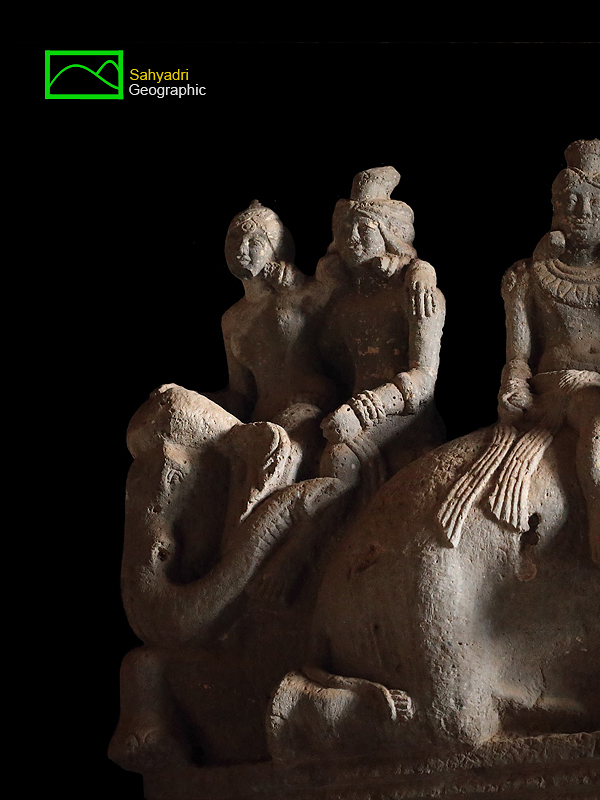 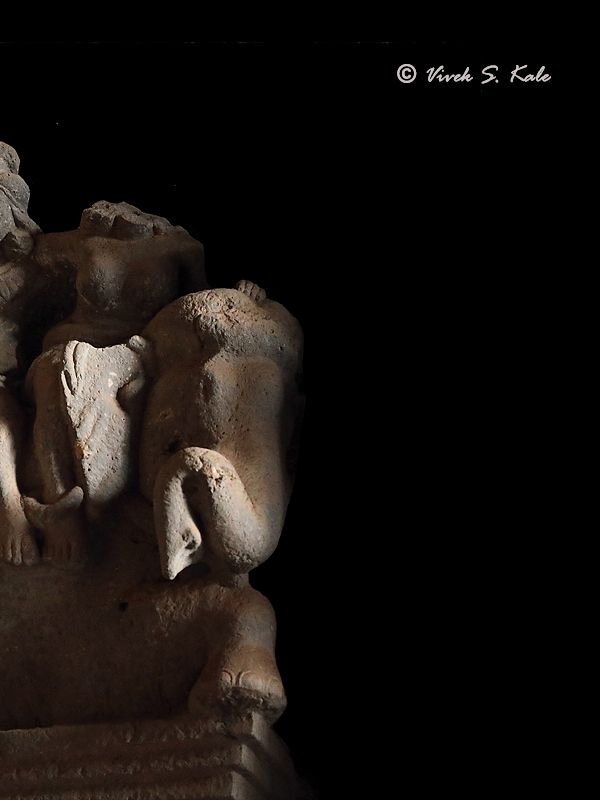 |
| |
| 12. Pillar R14, Chaityagriha, Karle Caves, Maval Tehsil, Pune district, Maharashtra, India |
| |
|
|
| |
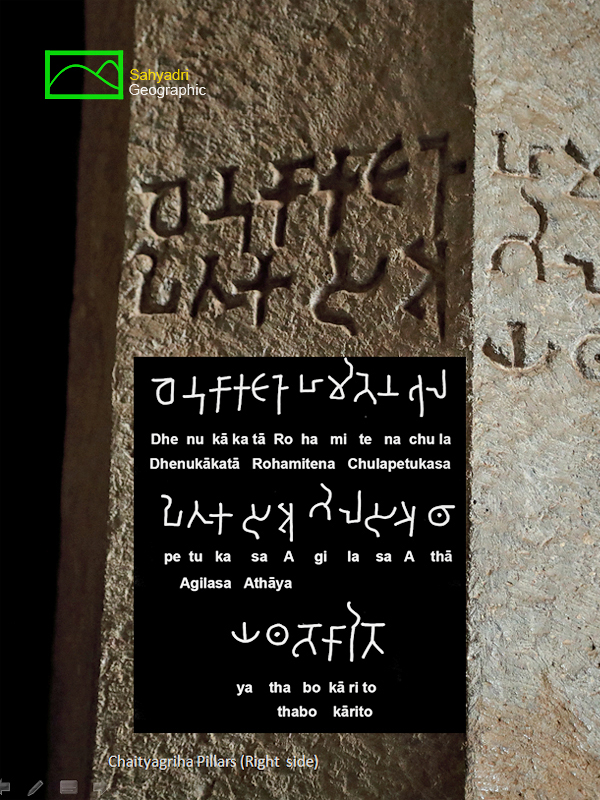  |
| |
| 13. Pillar R14, Chaityagriha, Karle Caves, Maval Tehsil, Pune district, Maharashtra, India |
| |
|
|
| |
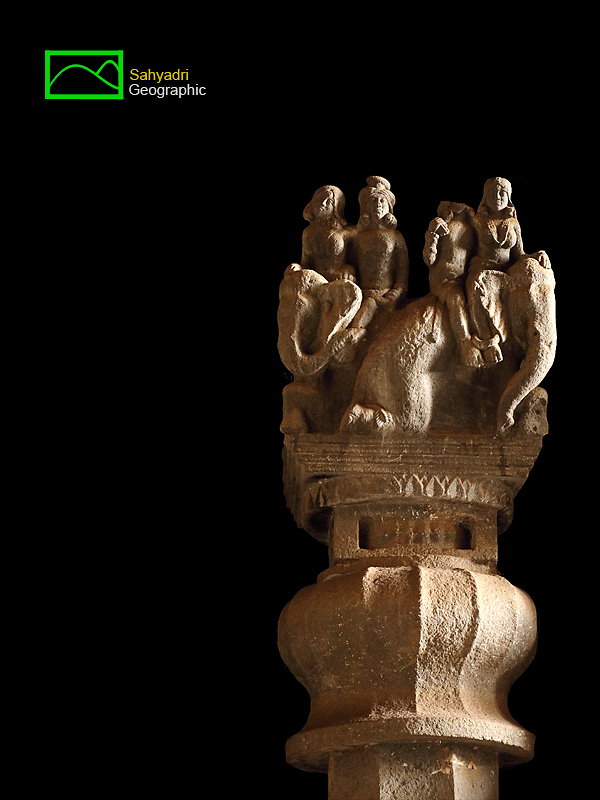  |
| |
| 14. Pillar R13, Chaityagriha, Karle Caves, Maval Tehsil, Pune district, Maharashtra, India |
| |
|
|
छायाचित्रात तेरावा अष्टकोनी खांब (उजव्या रांगेतली / दक्षिणेकडील रांगेतली) दाखविलेला आहे. छायाचित्रात खांबावरची पुढच्या बाजुची शिल्पे दाखविलेली आहेत. या शिल्पात दोन हत्ती आहेत. दोन्ही हत्तींवर स्त्री-पुरुष जोड़्या आरुढ झालेल्या आहेत. स्त्री शिल्पात कपाळावरची आभूषण (टिका), कंबर पटा , बांगड़्या, गळ्यात हार ही आभूषण दाखवलेली आहेत. पुरुष शिल्पाच्या हातात कडे आहेत. स्त्री आणि पुरुष पारंपारिक परिवेषात आहेत. पुरुष शिल्पात गळ्यातला हार आणि हातातील कडे कोरलेले आढळतात.
या खांबावर एक शिलालेख आहे. हा शिलालेख पाली भाषेत ब्राह्मी लिपीत कोरलेला आहे. शिलालेखांचे मराठी भाषांतर " धेनुकाकट चा य़वन धम्मध्यानम कडुन स्तंभाकरिता दान. " असे आहे.
या खांबाच्या मागच्या बाजूस स्त्री घोड़्यावर आरुढ झालेले पहावयास मिळतात आणि पुरुष स्फिन्क्स वर आरूढ झालेला दिसतो. स्फिन्क्स म्हणजे माणसाचा चेहरा असलेला प्राणी आहे. स्फिन्क्स च्या मनुष्य चेहरयाचे कान लांब आहेत.
|
|
Thirteenth octagonal pillar, (with sculptures on its capital) on right hand side (person facing stupa) i.e. on south side in Karla Chaityagriha is shown in the image. In this image, only the sculptures facing the main hall are highlighted and the image does not show the other details such as top of the pillar, backside of the pillar and wall behind. On one of the elephants a human pair of male and female is riding. On the other elephant other human pair of male and female riders can be seen.
Interesting ornaments such as waist jewelry, necklace, large anklets and forehead jewelry can be seen here on the female riders. The wrist bracelet can be seen on the male rider.
The elephant riders are dressed traditionally. One of the female has interesting hair style.
This pillar has male rider riding sphinx and female rider riding on horse on the alley side. Sphinx has human face with long ears.
This pillar has Prakrit inscription in Brahmi script. The meaning of the inscription is, " The gift of a pillar by Dhamadhyanam, a Yavana, from Dhenukakata "
|
|
|
| |
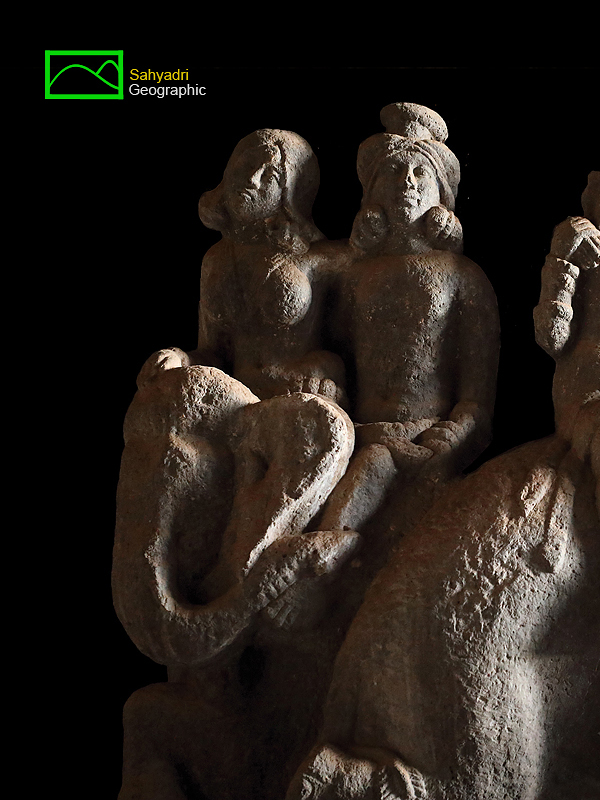 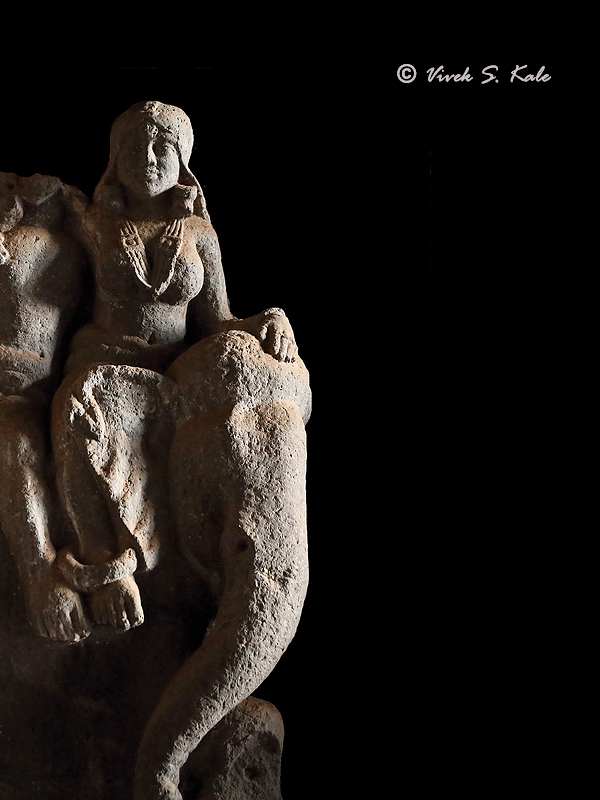 |
| |
| 15. Pillar R13, Chaityagriha, Karle Caves, Maval Tehsil, Pune district, Maharashtra, India |
| |
|
|
| |
  |
| |
| 16. Pillar R13, Chaityagriha, Karle Caves, Maval Tehsil, Pune district, Maharashtra, India |
| |
|
|
| |
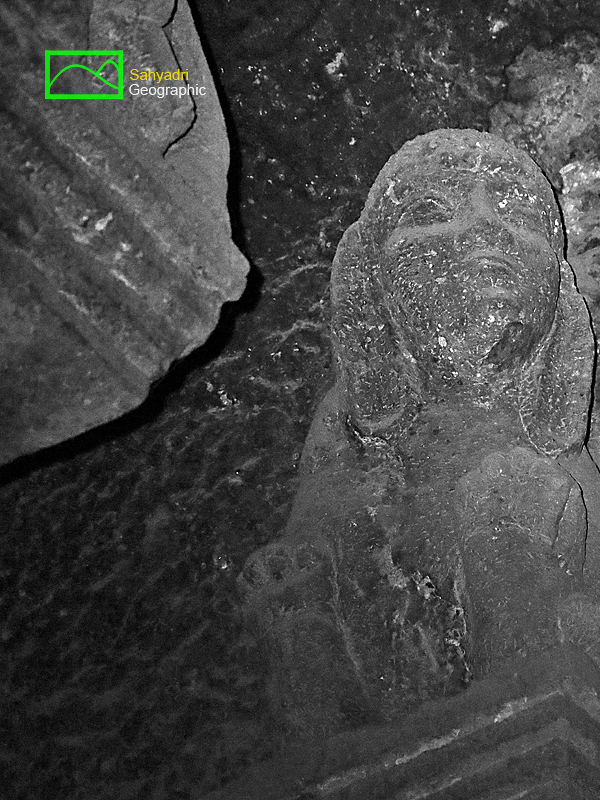 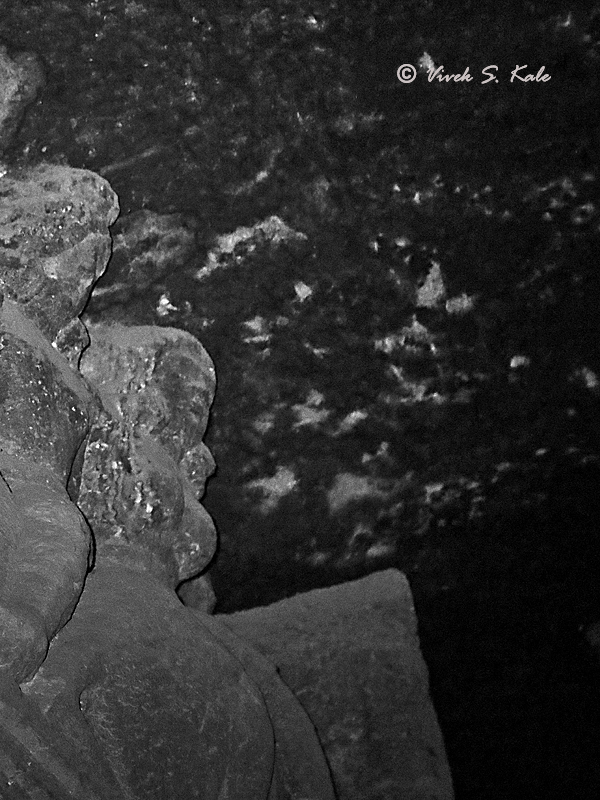 |
| |
| 17. Pillar R13, Chaityagriha, Karle Caves, Maval Tehsil, Pune district, Maharashtra, India |
| |
|
|
| |
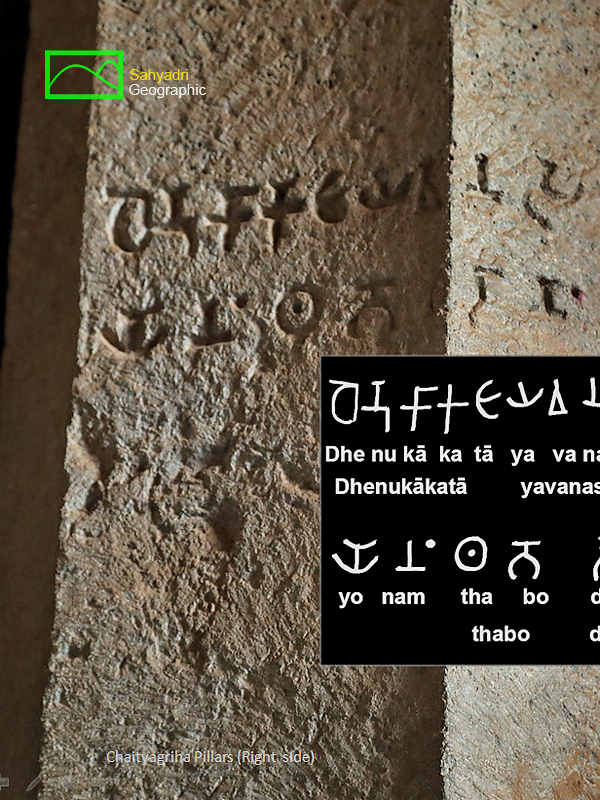 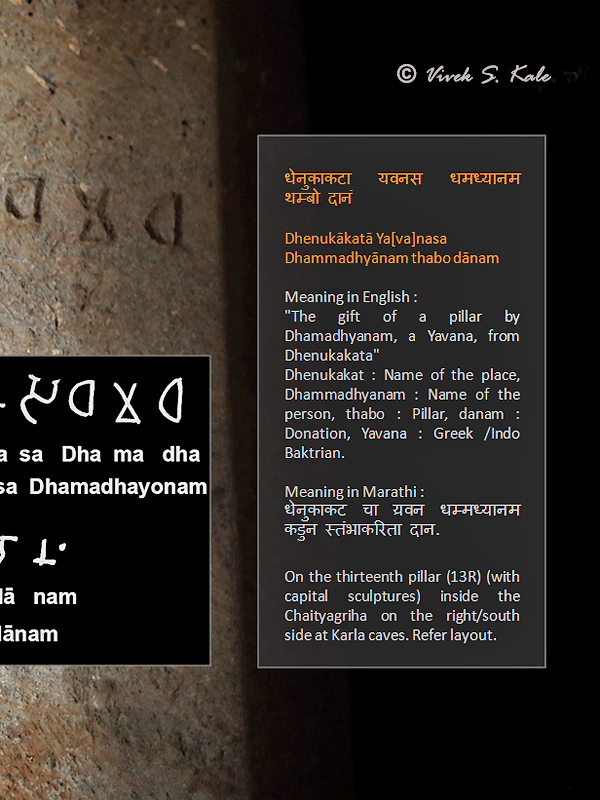 |
| |
| 18. Pillar R13, Chaityagriha, Karle Caves, Maval Tehsil, Pune district, Maharashtra, India |
| |
|
|
| |
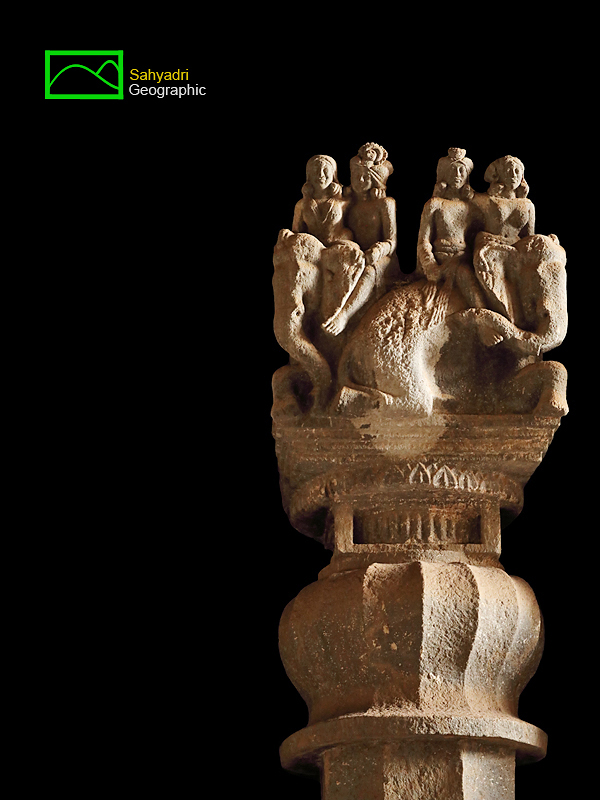  |
| |
| 19. Pillar R12, Chaityagriha, Karle Caves, Maval Tehsil, Pune district, Maharashtra, India |
| |
|
|
छायाचित्रात बारावा अष्टकोनी खांब (उजव्या रांगेतली / दक्षिणेकडील रांगेतली) दाखविलेला आहे. छायाचित्रात खांबावरची पुढच्या बाजुची शिल्पे दाखविलेली आहेत. या शिल्पात दोन हत्ती आहेत. दोन्ही हत्तींवर स्त्री-पुरुष जोड़्या आरुढ झालेल्या आहेत. स्त्री शिल्पात कपाळावरची आभूषण (टिका), कंबर पटा , बांगड़्या, गळ्यात हार ही आभूषण दाखवलेली आहेत. पुरुष शिल्पाच्या हातात कडे आहेत. स्त्री आणि पुरुष पारंपारिक परिवेषात आहेत. पुरुष शिल्पात गळ्यातला हार आणि हातातील कडे कोरलेले आढळतात.
एका पुरुष शिल्पाच्या मुकुटावर फुलांचे सुंदर कोरीव आहे.
या खांबावर शिलालेख नाही. या खांबाच्या मागच्या बाजूस स्त्री, पुरुष घोड़्यावर आरुढ झालेले पहावयास मिळतात.
|
|
Twelfth octagonal pillar, (with sculptures on its capital) on right hand side (person facing stupa) i.e. on south side in Karla Chaityagriha is shown in the image. In this image, only the sculptures facing the main hall are highlighted and the image does not show the other details such as top of the pillar, backside of the pillar and wall behind. On one of the elephants a human pair of male and female is riding. On the other elephant other human pair of male and female riders can be seen.
Interesting ornaments such as waist jewelry, necklace and forehead jewelry can be seen here on the female riders. The wrist bracelet can be seen on the male rider.
The elephant riders are dressed traditionally. One of the female has interesting hair style. One of the male has interesting head gear with unique intricate flower design on his headgear.
This pillar has male rider riding bull and female rider riding on horses on the alley side.
This pillar has does not have inscription.
|
|
|
| |
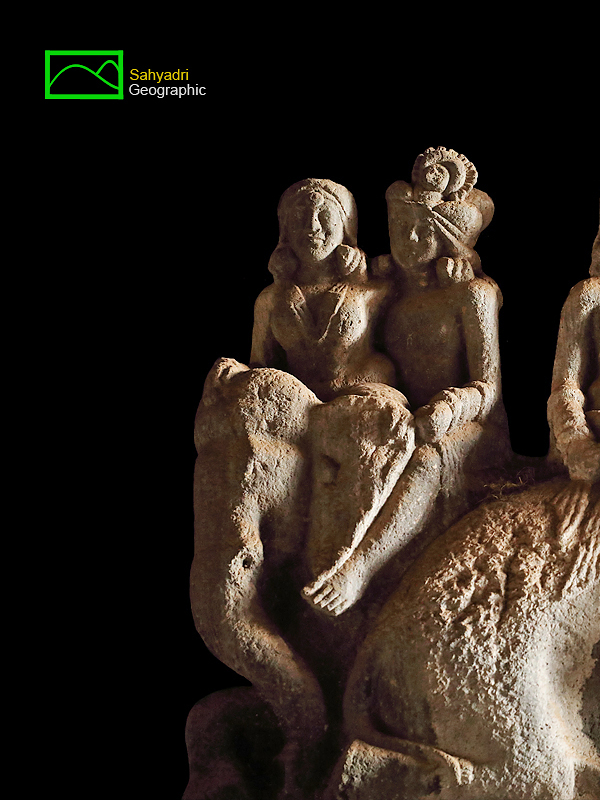 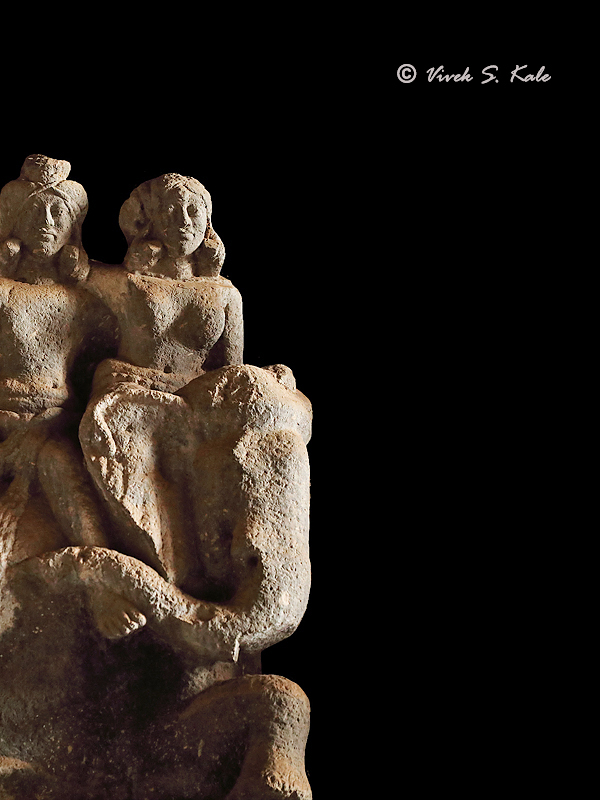 |
| |
| 20. Pillar R12, Chaityagriha, Karle Caves, Maval Tehsil, Pune district, Maharashtra, India |
| |
|
|
| |
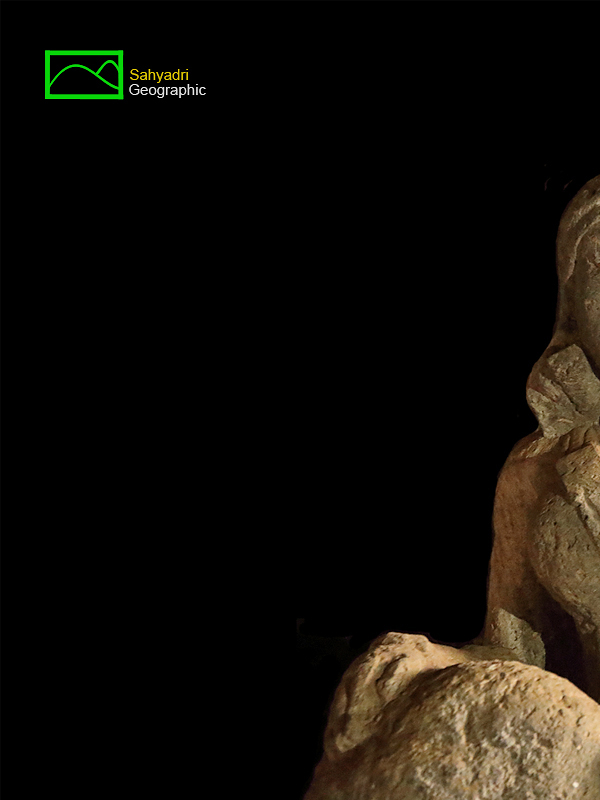 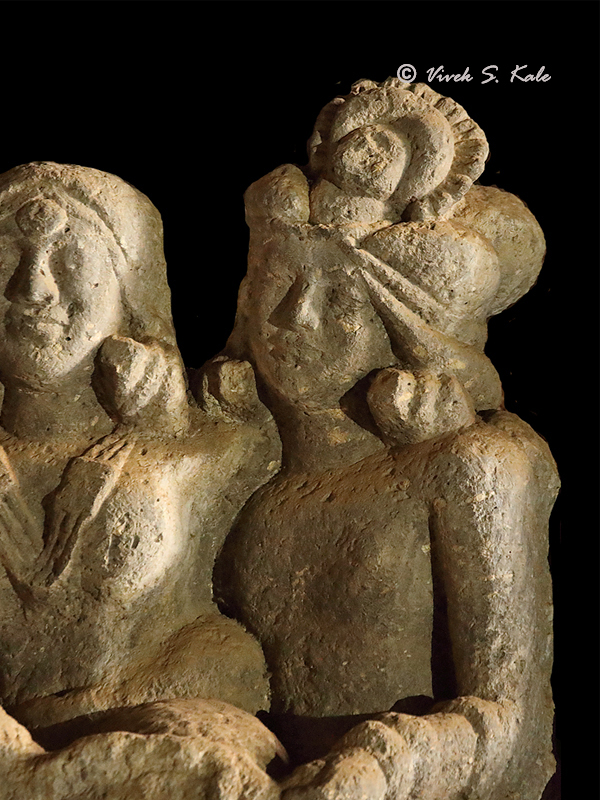 |
| |
| 21. Pillar R12, Chaityagriha, Karle Caves, Maval Tehsil, Pune district, Maharashtra, India |
| |
|
|
| |
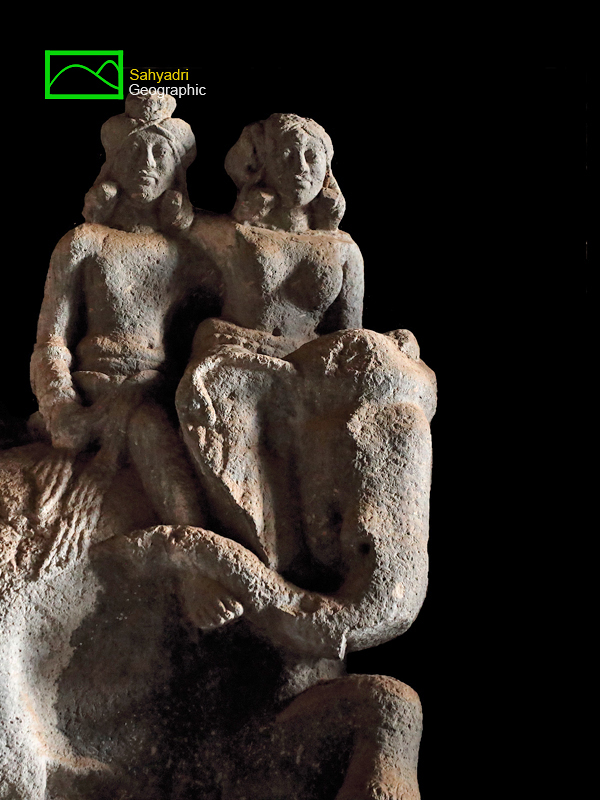  |
| |
| 22. Pillar R12, Chaityagriha, Karle Caves, Maval Tehsil, Pune district, Maharashtra, India |
| |
|
|
| |
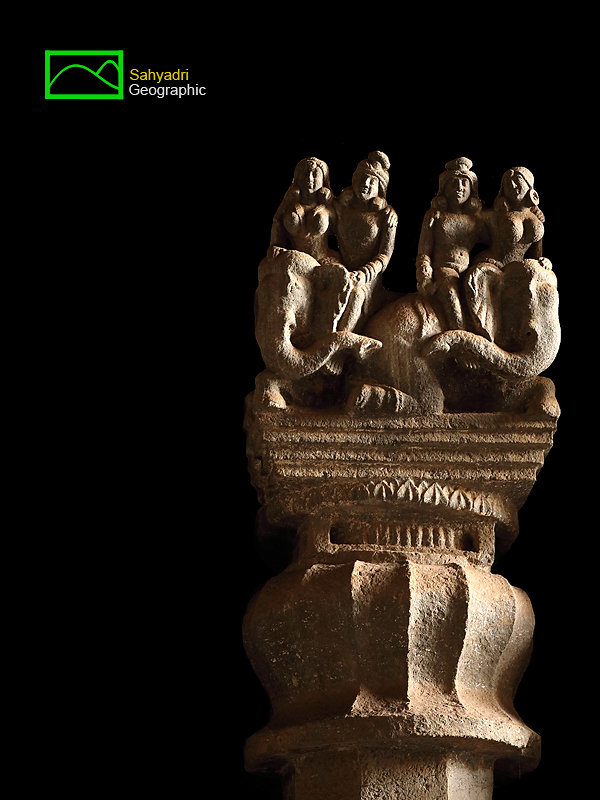  |
| |
| 23. Pillar R11, Chaityagriha, Karle Caves, Maval Tehsil, Pune district, Maharashtra, India |
| |
|
|
छायाचित्रात अकरावा अष्टकोनी खांब (उजव्या रांगेतली / दक्षिणेकडील रांगेतली) दाखविलेला आहे. छायाचित्रात खांबावरची पुढच्या बाजुची शिल्पे दाखविलेली आहेत. या शिल्पात दोन हत्ती आहेत. दोन्ही हत्तींवर स्त्री-पुरुष जोड़्या आरुढ झालेल्या आहेत. स्त्री शिल्पात कपाळावरची आभूषण (टिका), कंबर पटा , बांगड़्या, गळ्यात हार, वर्तुळाकार कर्ण आभूषण ही आभूषण दाखवलेली आहेत. पुरुष शिल्पाच्या हातात कडे आहेत. स्त्री आणि पुरुष पारंपारिक परिवेषात आहेत. पुरुष शिल्पात हातातील कडे कोरलेले आढळतात.
या खांबावर एक शिलालेख आहे. हा शिलालेख पाली भाषेत ब्राह्मी लिपीत कोरलेला आहे. शिलालेखांचे मराठी भाषांतर " धेनुकाकट च्या वाणी समाजाकडुन स्तंभाकरिता दान. " असे आहे.
या खांबाच्या मागच्या बाजूस स्त्री, पुरुष घोड़्यावर आरुढ झालेले पहावयास मिळतात.
|
|
Eleventh octagonal pillar, (with sculptures on its capital) on right hand side (person facing stupa) i.e. on south side in Karla Chaityagriha is shown in the image. In this image, only the sculptures facing the main hall are highlighted and the image does not show the other details such as top of the pillar, backside of the pillar and wall behind. On one of the elephants a human pair of male and female is riding. On the other elephant other human pair of male and female riders can be seen.
Interesting ornaments such as waist jewelry, necklace, circular earrings and forehead jewelry can be seen here on the female riders. The wrist bracelet can be seen on the male rider.
The elephant riders are dressed traditionally. One of the female has interesting hair style with the headgear.
This pillar has male and female human riders riding on horses on the alley side.
This pillar has Prakrit inscription in Brahmi script. The meaning of the inscription is, " The gift of a pillar by community of traders, from Dhenukakata."
|
|
|
| |
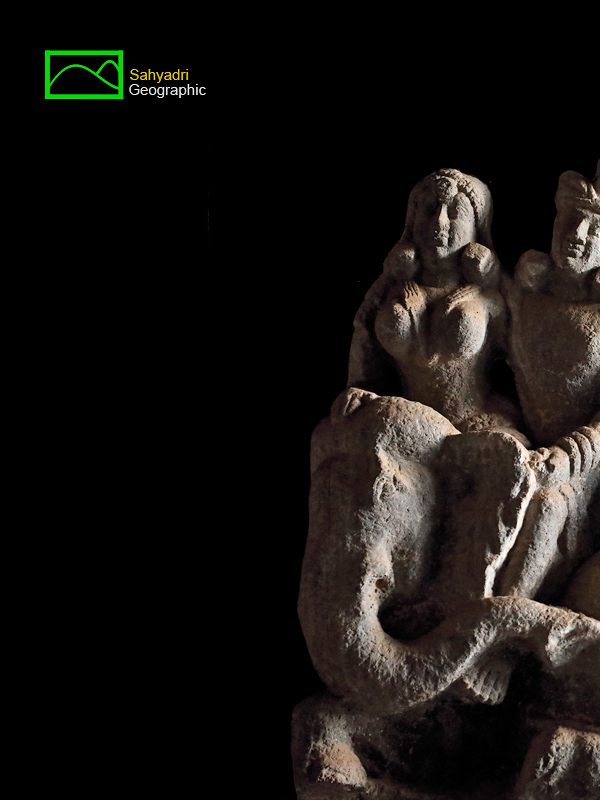 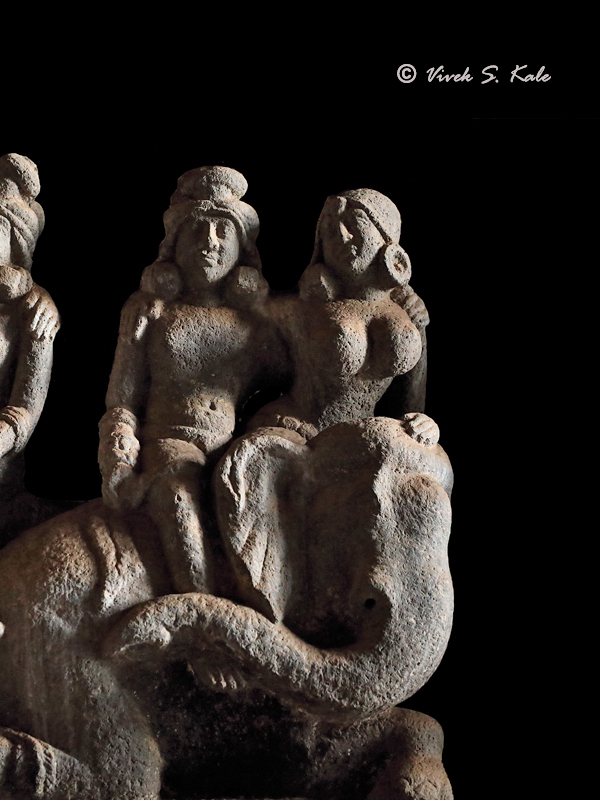 |
| |
| 24. Pillar R11, Chaityagriha, Karle Caves, Maval Tehsil, Pune district, Maharashtra, India |
| |
|
|
| |
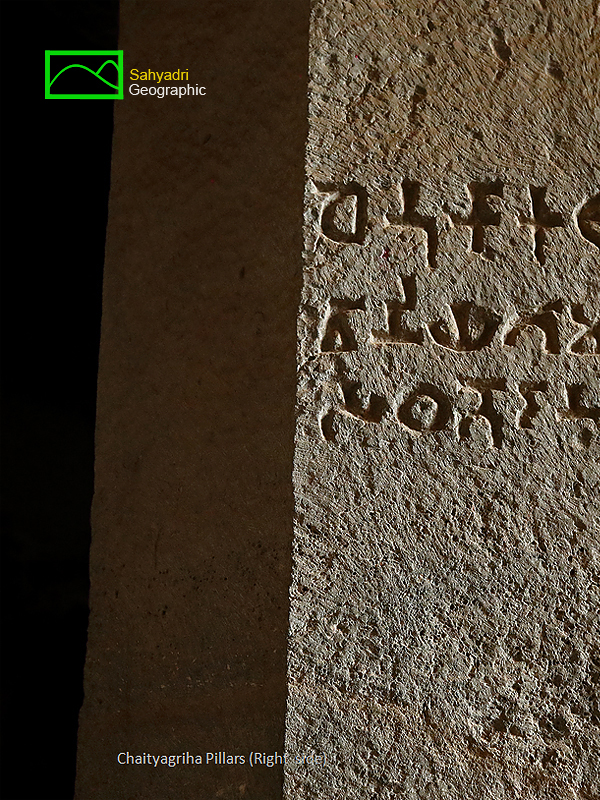 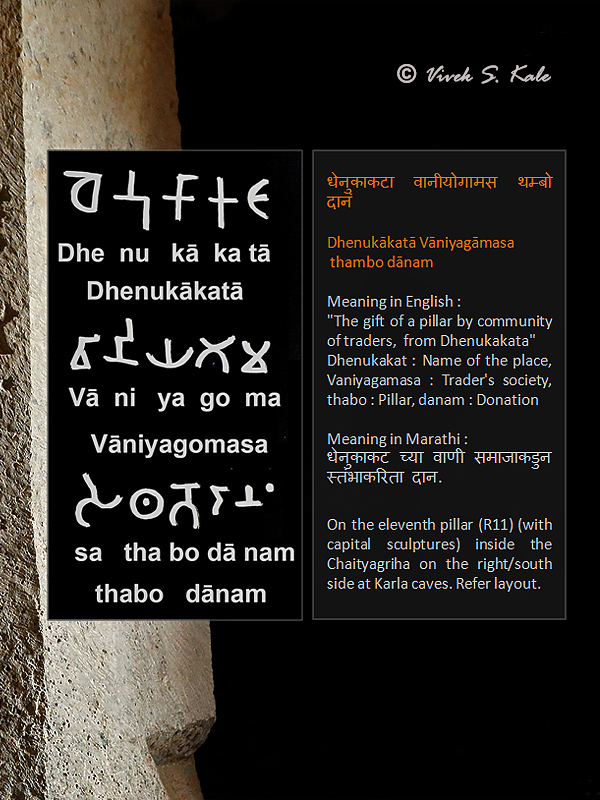 |
| |
| 25. Pillar R11, Chaityagriha, Karle Caves, Maval Tehsil, Pune district, Maharashtra, India |
| |
|
|
| |
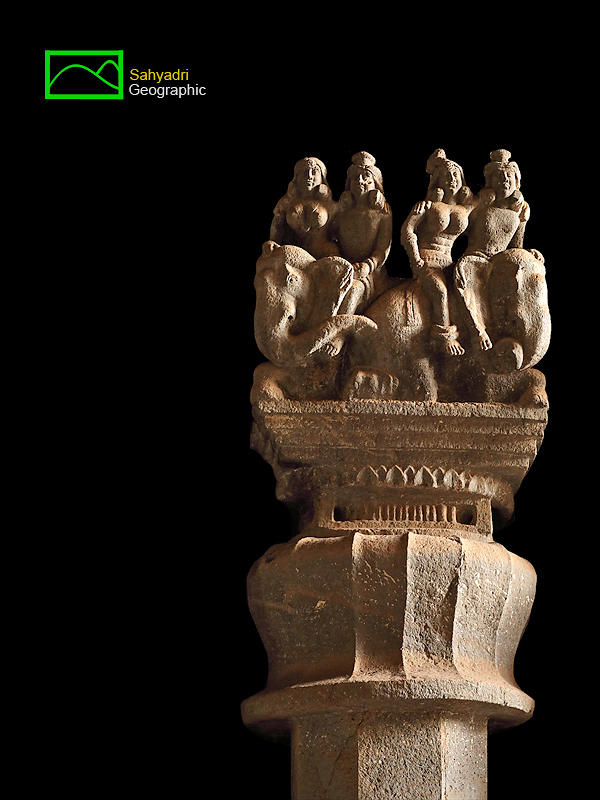  |
| |
| 26. Pillar R10, Chaityagriha, Karle Caves, Maval Tehsil, Pune district, Maharashtra, India |
| |
|
|
छायाचित्रात दहावा अष्टकोनी खांब (उजव्या रांगेतली / दक्षिणेकडील रांगेतली) दाखविलेला आहे. छायाचित्रात खांबावरची पुढच्या बाजुची शिल्पे दाखविलेली आहेत. या शिल्पात दोन हत्ती आहेत. दोन्ही हत्तींवर स्त्री-पुरुष जोड़्या आरुढ झालेल्या आहेत. स्त्री शिल्पात कपाळावरची आभूषण (टिका), कंबर पटा , बांगड़्या, गळ्यात हार ही आभूषण दाखवलेली आहेत. पुरुष शिल्पाच्या हातात कडे आहेत. स्त्री आणि पुरुष पारंपारिक परिवेषात आहेत. पुरुष शिल्पात हातातील कडे कोरलेले आढळतात.
या खांबावर शिलालेख नाही.
या खांबाच्या मागच्या बाजूस स्त्री, पुरुष घोड़्यावर आरुढ झालेले पहावयास मिळतात.
|
|
Tenth octagonal pillar, (with sculptures on its capital) on right hand side (person facing stupa) i.e. on south side in Karla Chaityagriha is shown in the image. In this image, only the sculptures facing the main hall are highlighted and the image does not show the other details such as top of the pillar, backside of the pillar and wall behind. On one of the elephants a human pair of male and female is riding. On the other elephant other human pair of male and female riders can be seen.
Interesting ornaments such as waist jewelry, necklace, large anklets and forehead jewelry can be seen here on the female riders. The wrist bracelet can be seen on the male rider.
The elephant riders are dressed traditionally. One of the female has interesting hair style.
This pillar has male and female human riders riding on horses on the alley side.
This pillar does not have any inscription.
|
|
|
| |
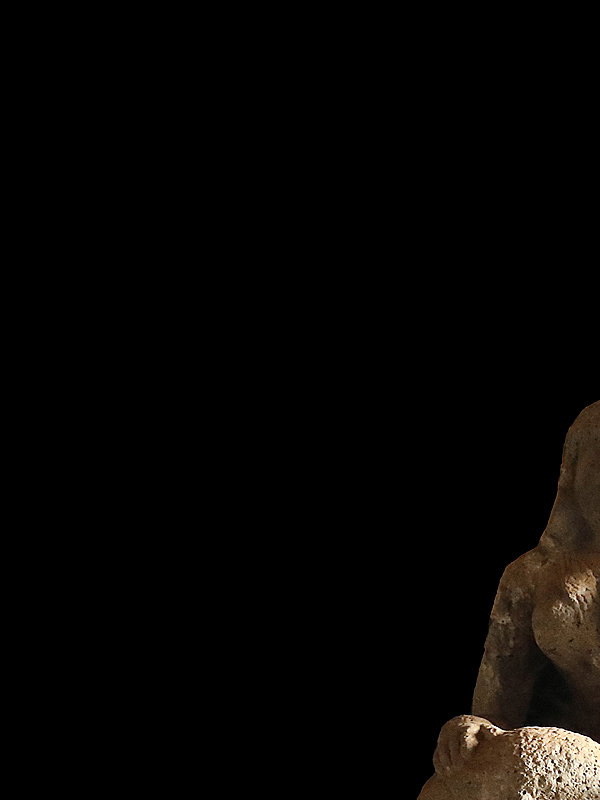 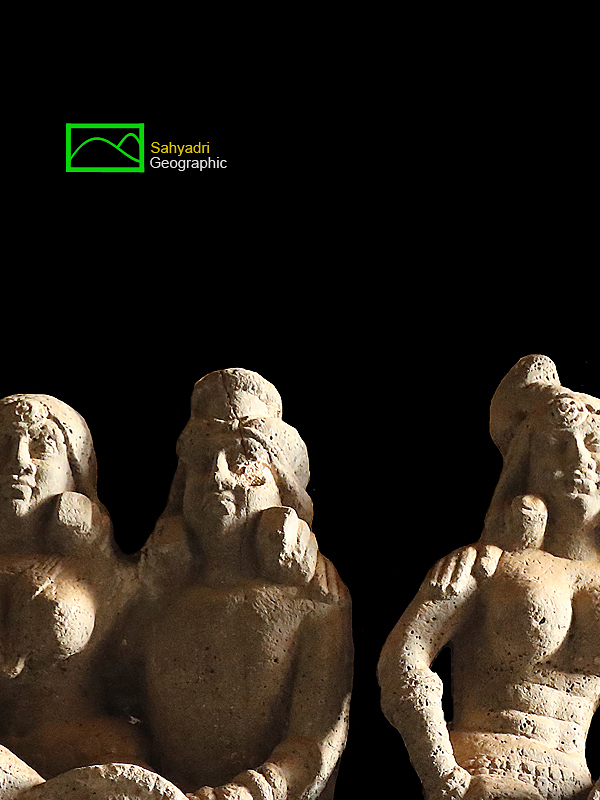 |
| |
| 27. Pillar R10, Chaityagriha, Karle Caves, Maval Tehsil, Pune district, Maharashtra, India |
| |
|
|
| |
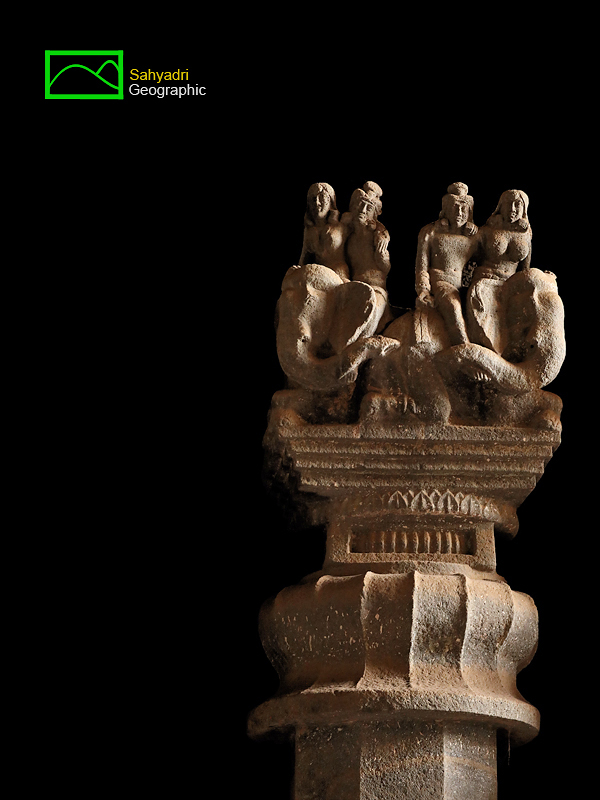  |
| |
| 28. Pillar R09, Chaityagriha, Karle Caves, Maval Tehsil, Pune district, Maharashtra, India |
| |
|
|
छायाचित्रात नववा अष्टकोनी खांब (उजव्या रांगेतली / दक्षिणेकडील रांगेतली) दाखविलेला आहे. छायाचित्रात खांबावरची पुढच्या बाजुची शिल्पे दाखविलेली आहेत. या शिल्पात दोन हत्ती आहेत. दोन्ही हत्तींवर स्त्री-पुरुष जोड़्या आरुढ झालेल्या आहेत. स्त्री शिल्पात कपाळावरची आभूषण (टिका), कंबर पटा , बांगड़्या, गळ्यात हार ही आभूषण दाखवलेली आहेत. पुरुष शिल्पाच्या हातात कडे आहेत. स्त्री आणि पुरुष पारंपारिक परिवेषात आहेत. पुरुष शिल्पात हातातील कडे कोरलेले आढळतात.
या खांबावर शिलालेख नाही.
या खांबाच्या मागच्या बाजूस स्त्री, पुरुष बैल आणि घोड़्यावर आरुढ झालेले पहावयास मिळतात.
|
|
Ninth octagonal pillar, (with sculptures on its capital) on right hand side (person facing stupa) i.e. on south side in Karla Chaityagriha is shown in the image. In this image, only the sculptures facing the main hall are highlighted and the image does not show the other details such as top of the pillar, backside of the pillar and wall behind. On one of the elephants a human pair of male and female is riding. On the other elephant other human pair of male and female riders can be seen.
Interesting ornaments such as waist jewelry, necklace and forehead jewelry can be seen here on the female riders. The wrist bracelet can be seen on the male rider.
The elephant riders are dressed traditionally.
This pillar has male rider riding bull and female human rider riding on horse on the alley side.
This pillar does not have any inscription.
|
|
|
| |
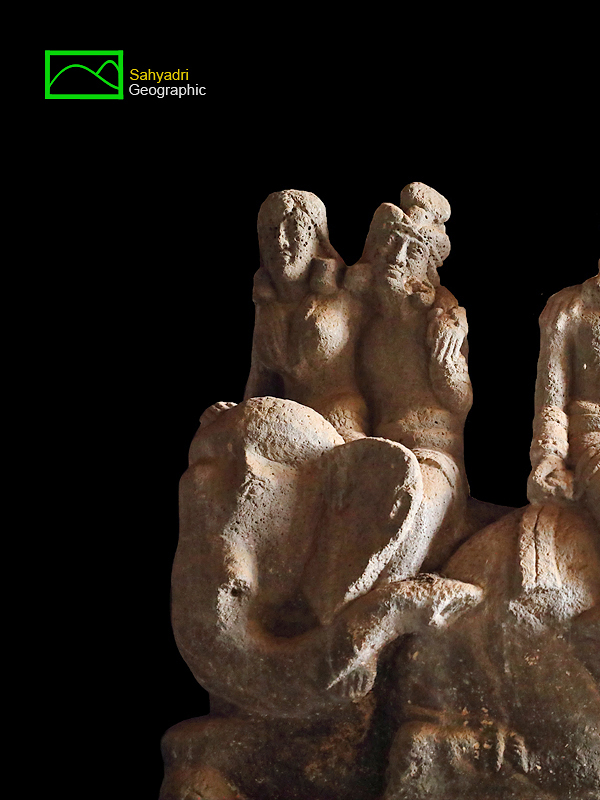  |
| |
| 29. Pillar R09, Chaityagriha, Karle Caves, Maval Tehsil, Pune district, Maharashtra, India |
| |
|
|
| |
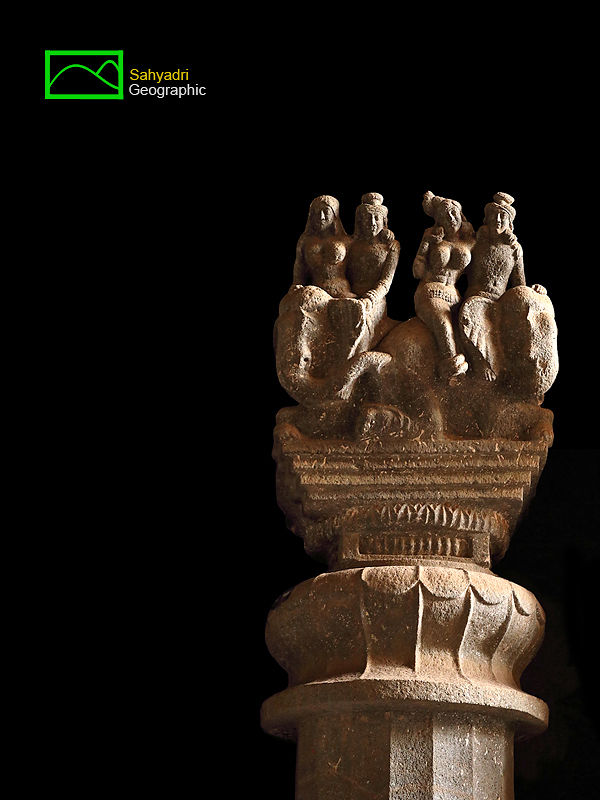 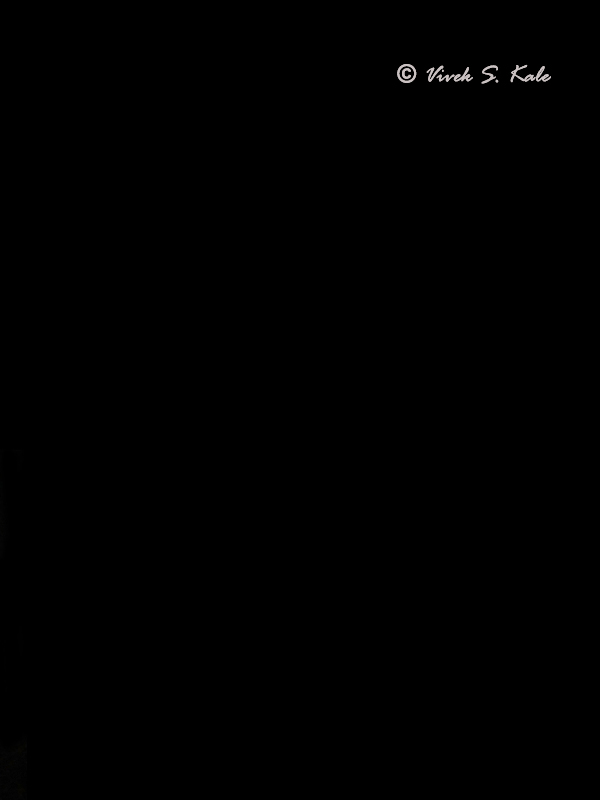 |
| |
| 30. Pillar R08, Chaityagriha, Karle Caves, Maval Tehsil, Pune district, Maharashtra, India |
| |
|
|
| |
 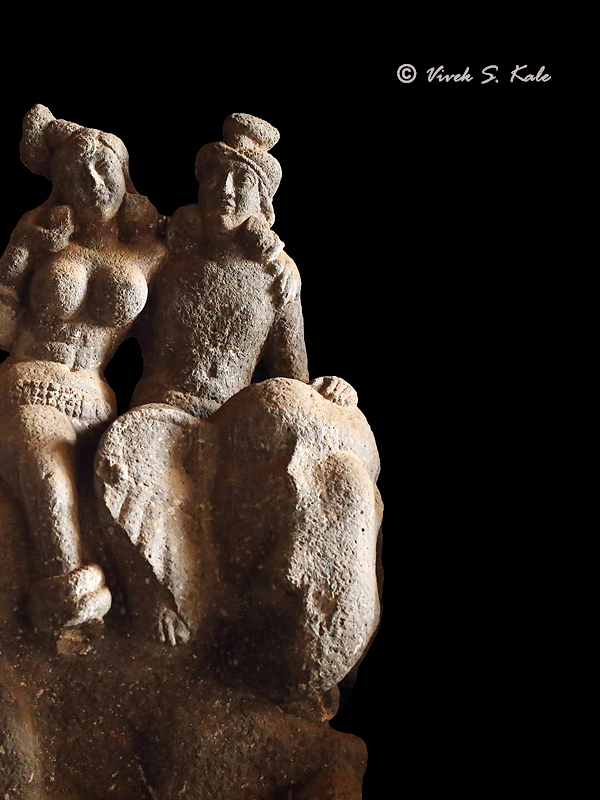 |
| |
| 31. Pillar R08, Chaityagriha, Karle Caves, Maval Tehsil, Pune district, Maharashtra, India |
| |
|
|
छायाचित्रात आठवा
अष्टकोनी खांब (उजव्या रांगेतली / दक्षिणेकडील रांगेतली) दाखविलेला आहे. छायाचित्रात खांबावरची पुढच्या बाजुची शिल्पे दाखविलेली आहेत. या शिल्पात दोन हत्ती आहेत. दोन्ही हत्तींवर स्त्री-पुरुष जोड़्या आरुढ झालेल्या आहेत. स्त्री शिल्पात कपाळावरची आभूषण (टिका), कंबर पटा , बांगड़्या, वर्तुळाकार कर्ण आभूषण ही आभूषण दाखवलेली आहेत. पुरुष शिल्पाच्या हातात कडे आहेत. स्त्री आणि पुरुष पारंपारिक परिवेषात आहेत. पुरुष शिल्पात हातातील कडे कोरलेले आढळतात.
या खांबावर एक शिलालेख आहे. हा शिलालेख पाली भाषेत ब्राह्मी लिपीत कोरलेला आहे. शिलालेखांचे मराठी भाषांतर " गोनेकाकसा चा धमुल उपासकाकडुन स्तंभाकरिता दान. " असे आहे.
या खांबाच्या मागच्या बाजूस स्त्री, पुरुष घोड़्यावर आरुढ झालेले पहावयास मिळतात.
या खांबावर काही चिन्हे कोरलेली आहेत. हा खांब अष्ट्कोनी नसुन त्याला सोळा कोन/बाजू आहेत. यावर एका खांबाजवळ दोन हरिणे बसलेले एक चित्र कोरलेले आहे. या चित्रातील खांबावर कदाचित धर्मचक्र असावे. या ठिकाणी एक लहान भोक आहे. यात कदाचित काही अवशेष ठेवलेले असावेत. याच्या बाजुला एक स्तुप आणि एक सिंहस्तंभ कोरलेला आहे.
|
|
Eighth octagonal pillar, (with sculptures on its capital) on right hand side (person facing stupa) i.e. on south side in Karla Chaityagriha is shown in the image. In this image, only the sculptures facing the main hall are highlighted and the image does not show the other details such as top of the pillar, backside of the pillar and wall behind. On one of the elephants a human pair of male and female is riding. On the other elephant other human pair of male and female riders can be seen.
Interesting ornaments such as waist jewelry, forehead jewelry, circular earrings can be seen here on the female riders. The wrist bracelet can be seen on the male rider.
The elephant riders are dressed traditionally. None of the riders are wearing the necklace. One of the female rider has interesting hair style. This pillar has male and female human riders riding on horses on the alley side.
This pillar has Prakrit inscription in Brahmi script. The meaning of the inscription is, "The gift of a pillar by Dhamulaupasekasa, from Gonekakasa“
The pillar also has few symbols sculptured on it. This pillar has 16 sides as against eight found in all other pillars. There is a sculpture of a pillar with 2 dears seating at the base. The top of this small pillar sculpture had some symbol, probabaly dharmachakra where now there a small hole. There is a symbol of the stupa and the symbol of a lion pillar .
|
|
|
| |
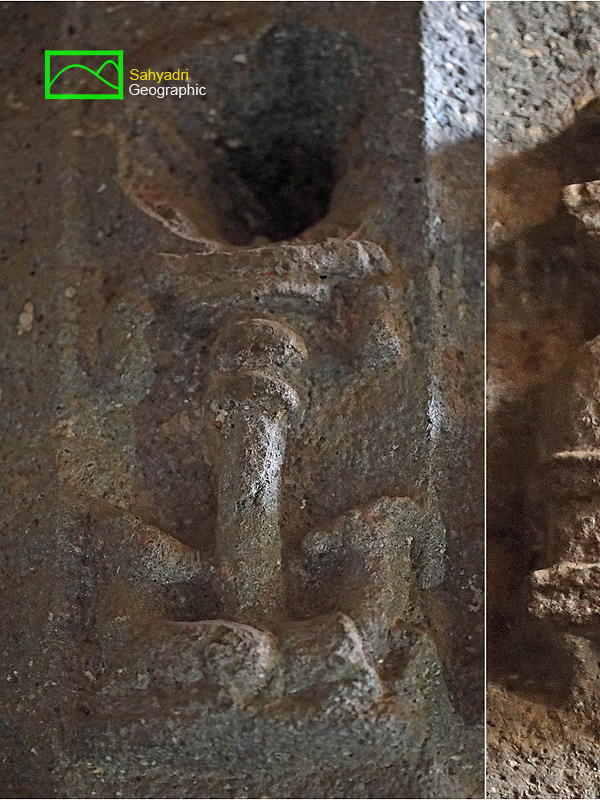 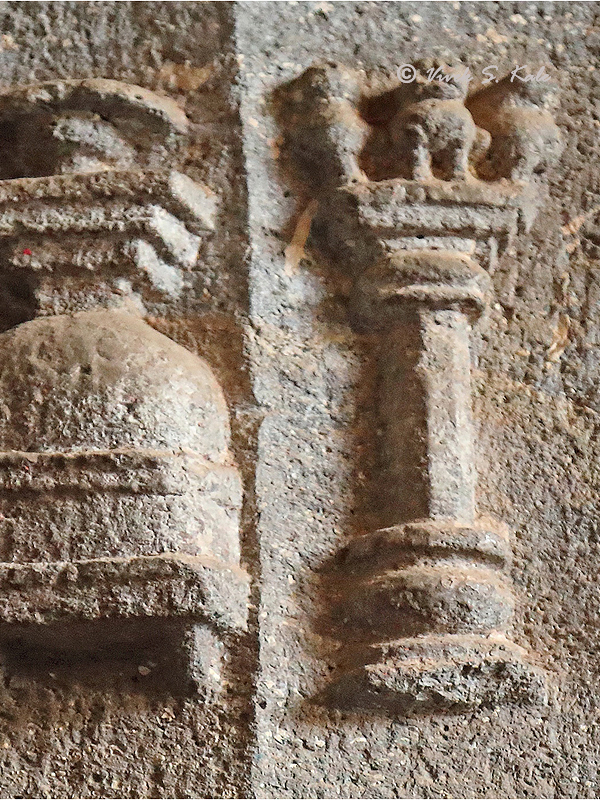 |
| |
| 32. Pillar R08, Chaityagriha, Karle Caves, Maval Tehsil, Pune district, Maharashtra, India |
| |
|
|
| |
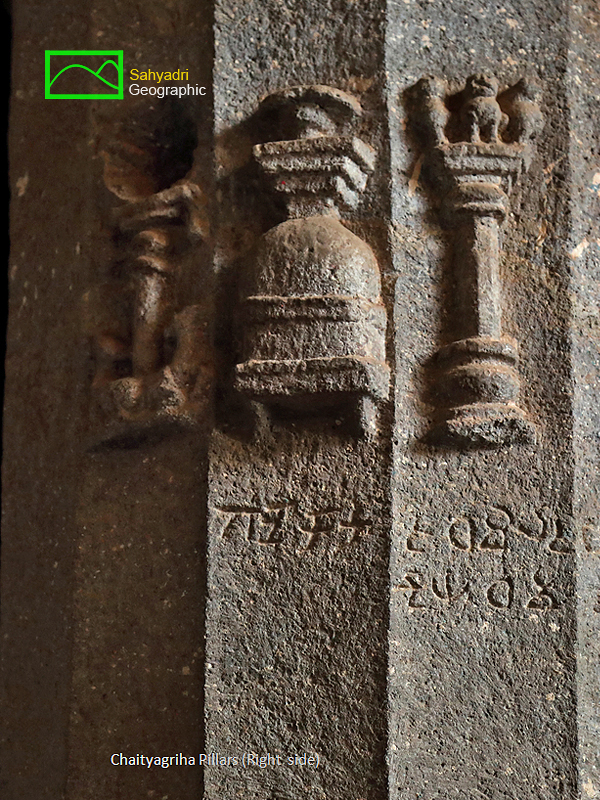 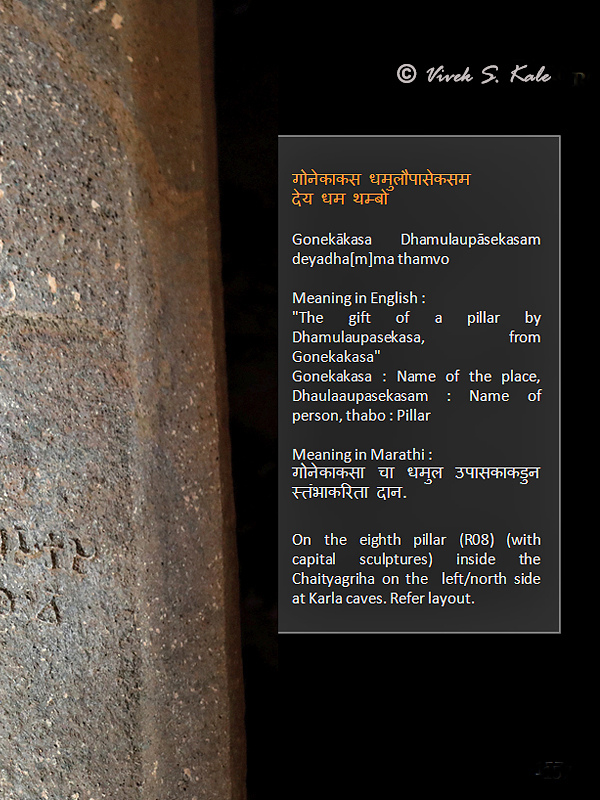 |
| |
| 33. Pillar R08, Chaityagriha,Karle Caves, Maval Tehsil, Pune district, Maharashtra, India |
| |
|
|
| |
 |
| |
|
|
References :
1. Cave temples of India, London, 1880, Fergusson James and Burgess James.
2. Gazetters of Bombay Presidency, Poona District, Volume XVIII, 1885.
3. Buddhist architecture of western India, 1981, S. Nagraju.
4. Burgess James and Inderaji Pandit Bhagavanlal, Inscriptions from the cave temples of western India, ASWI X, London, 1881.
|
| |
|
|
| |
|







































































